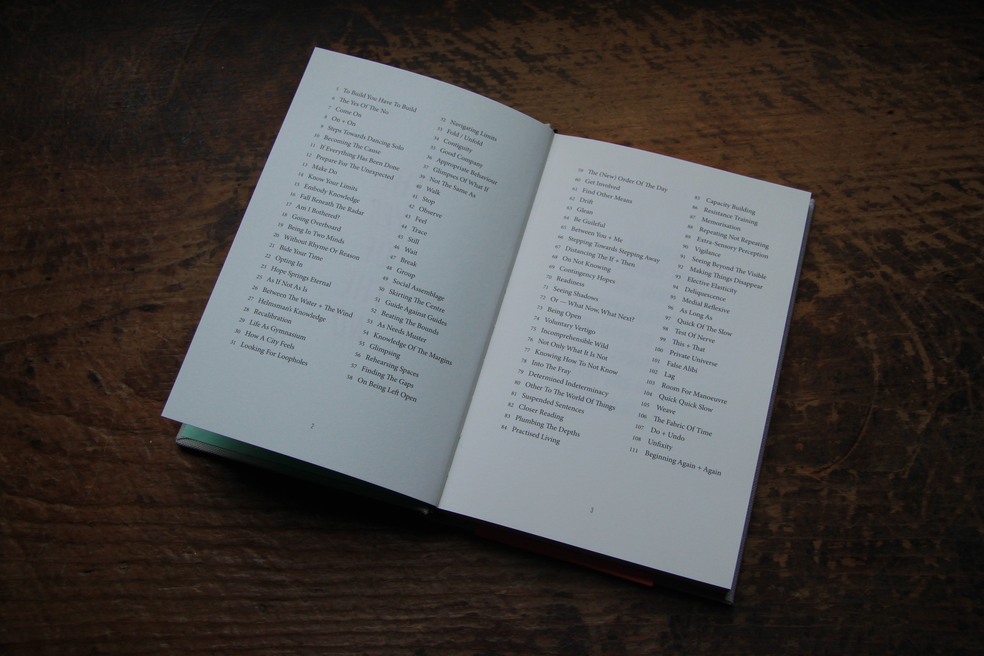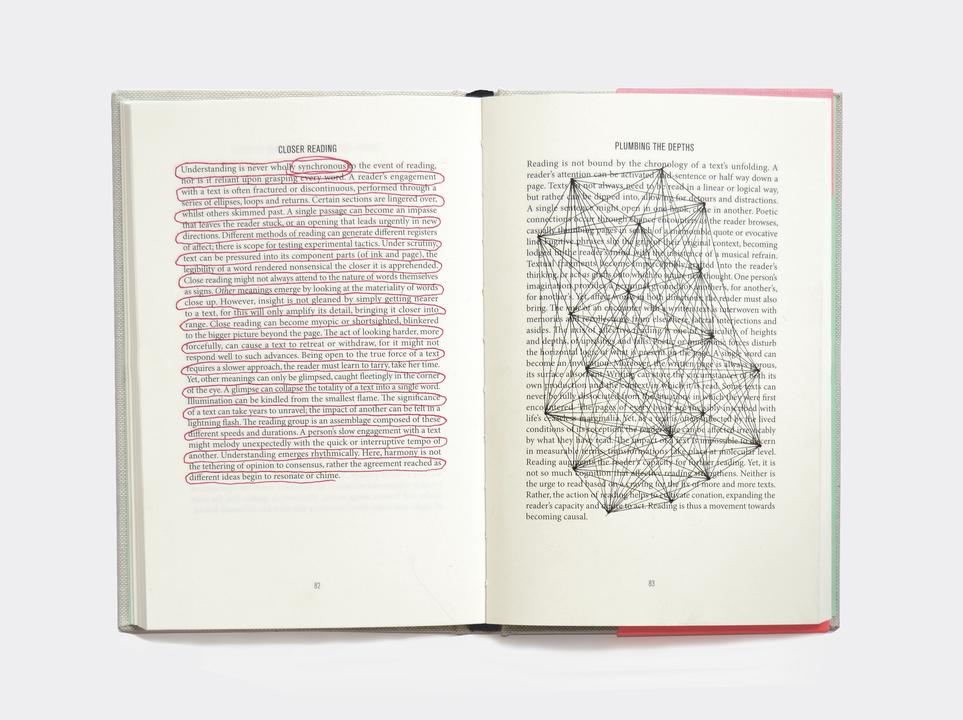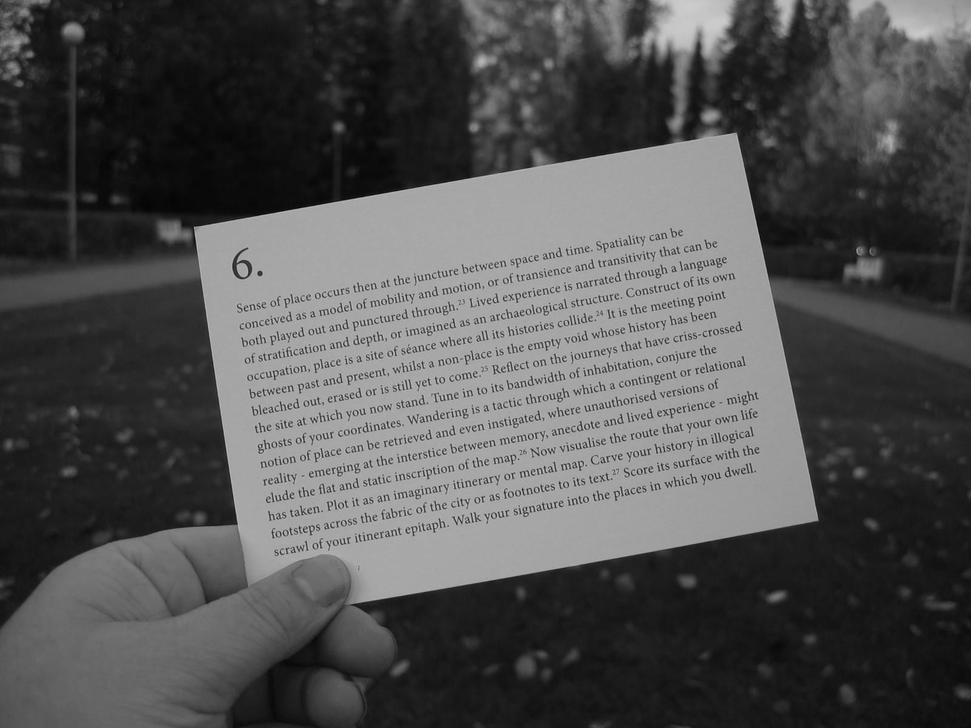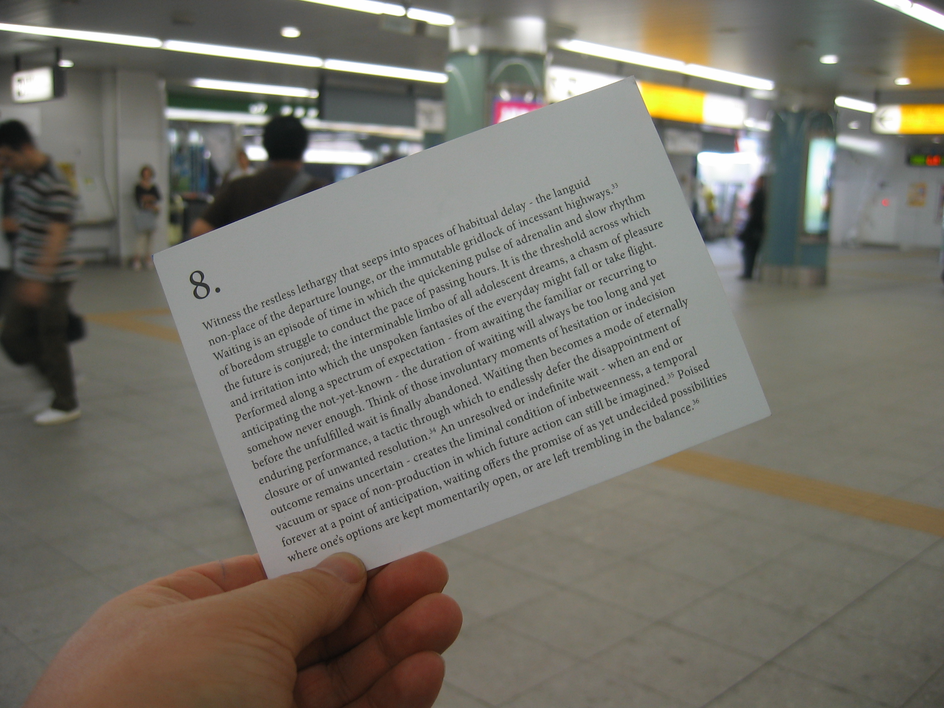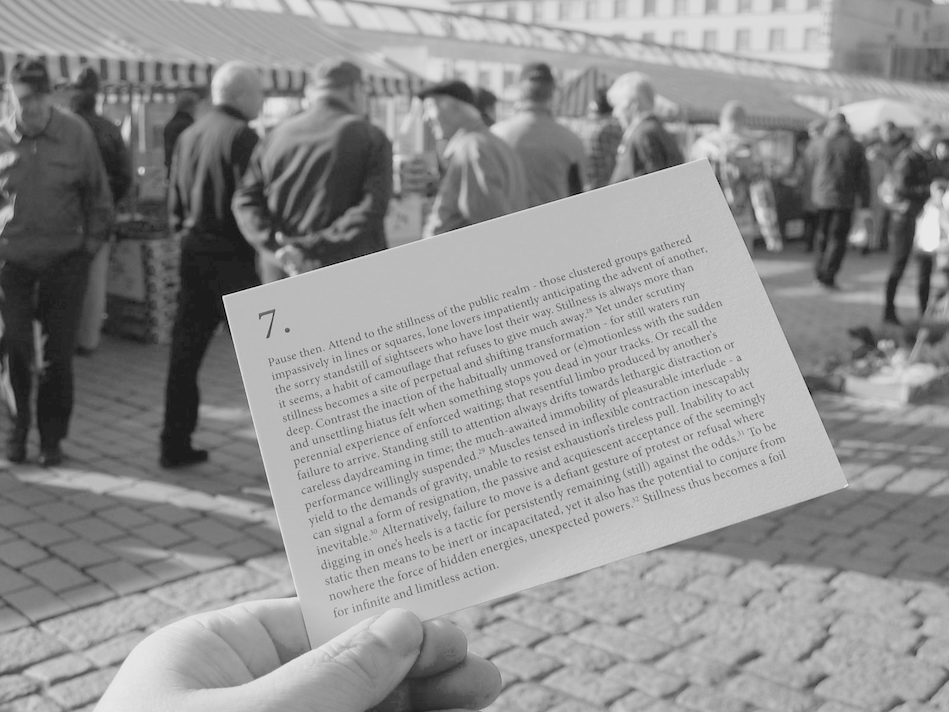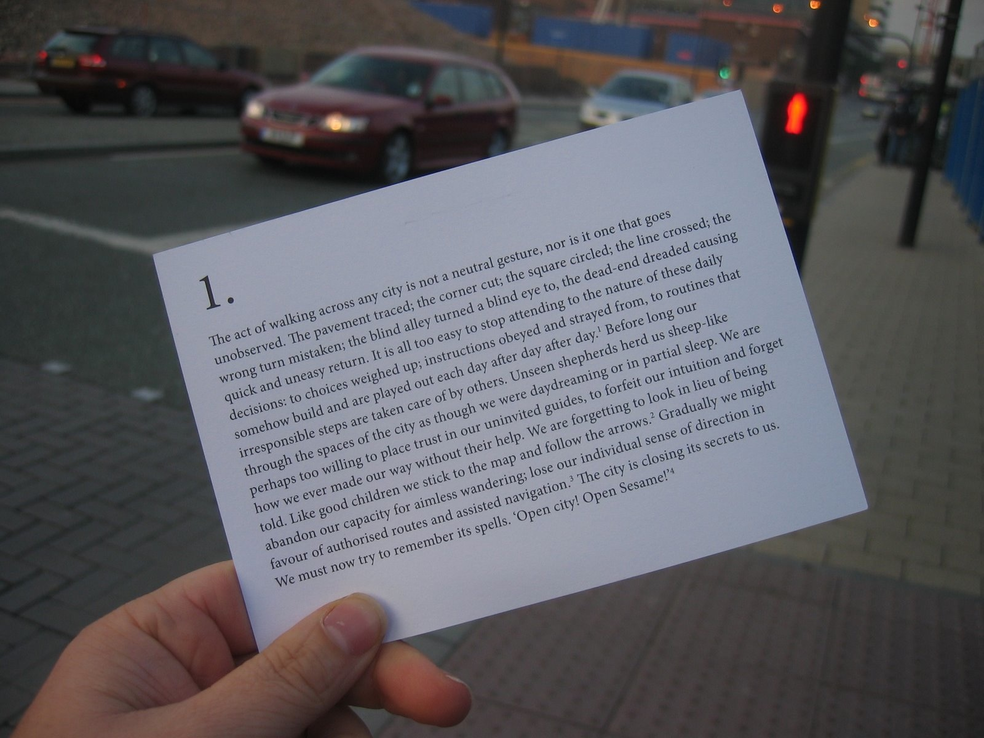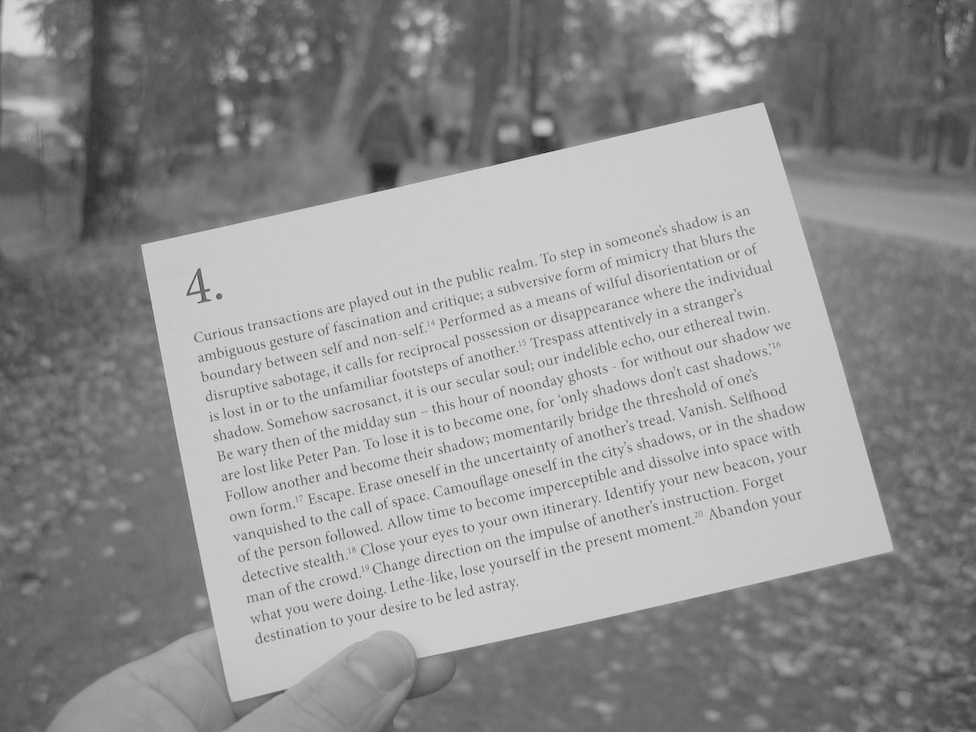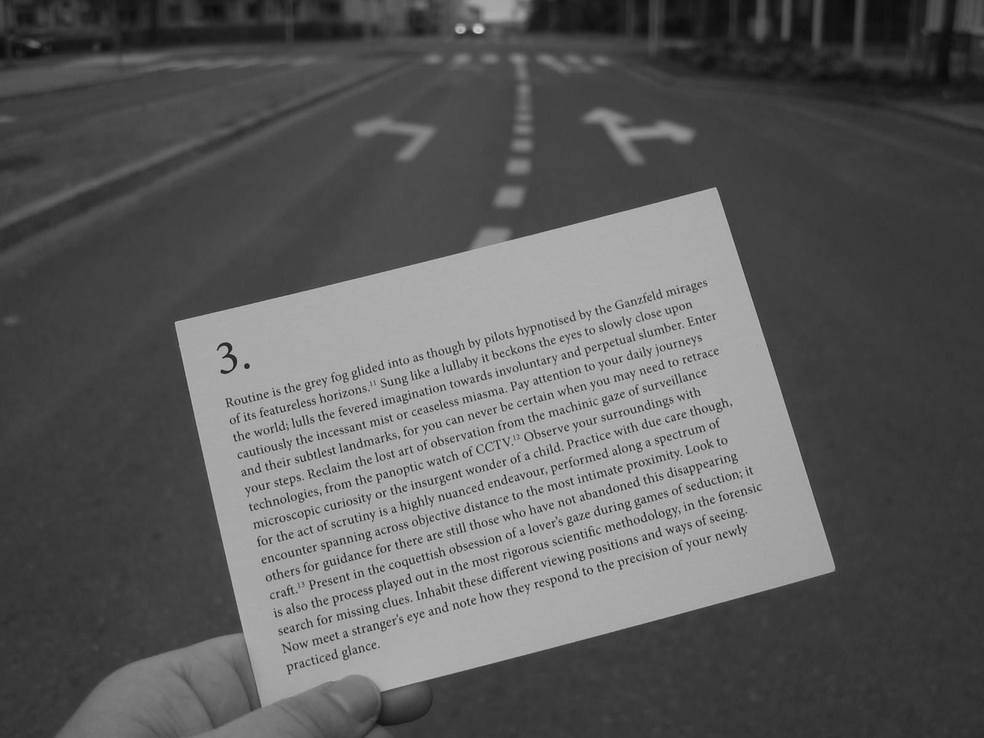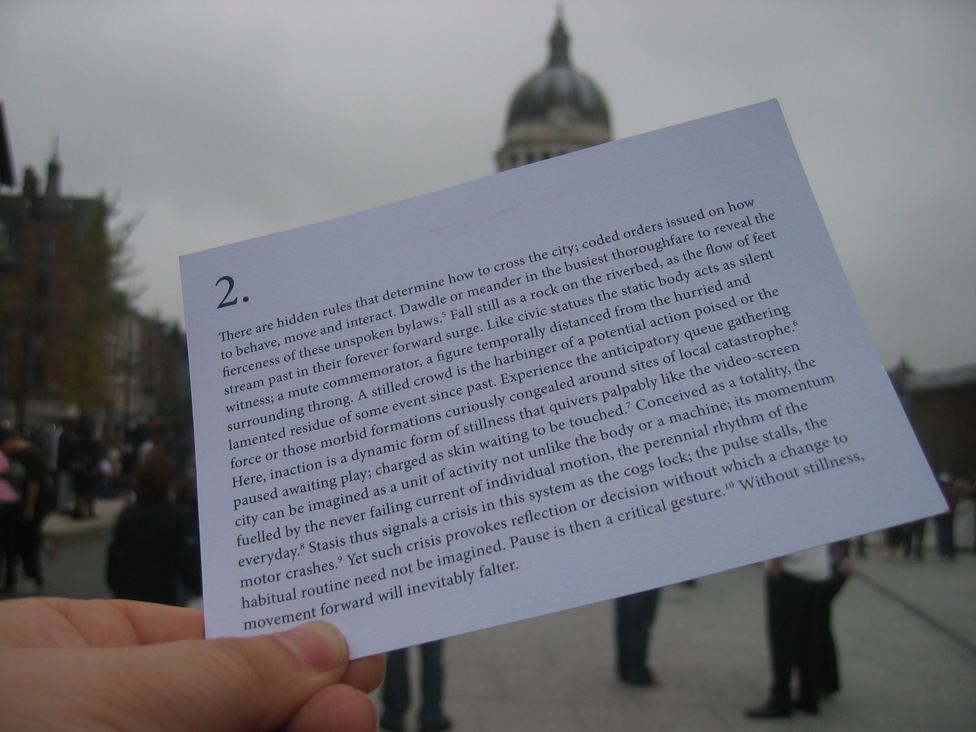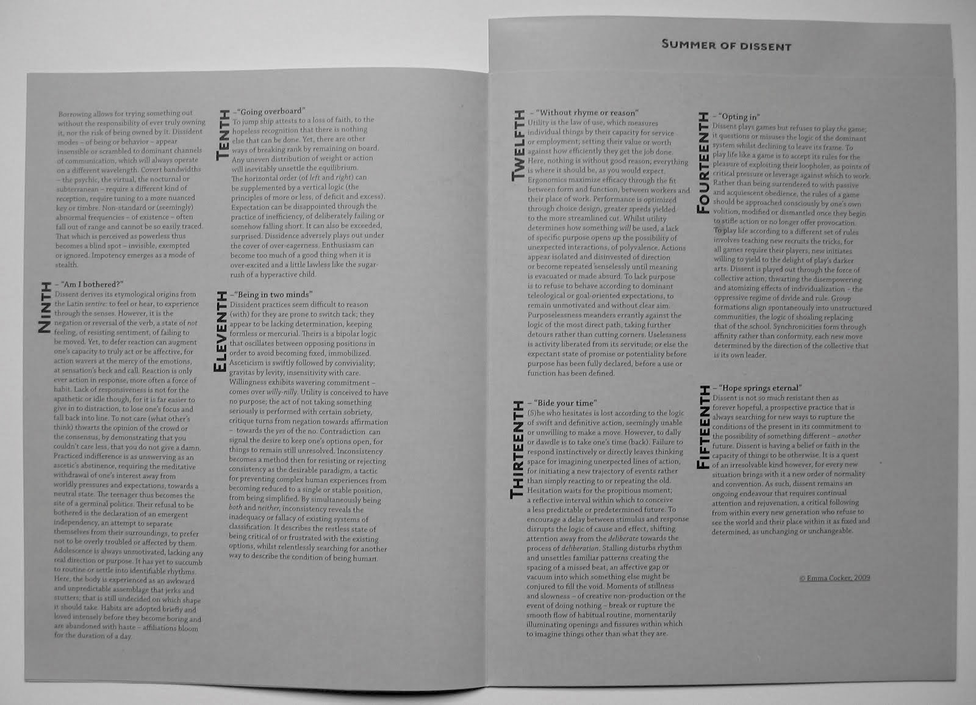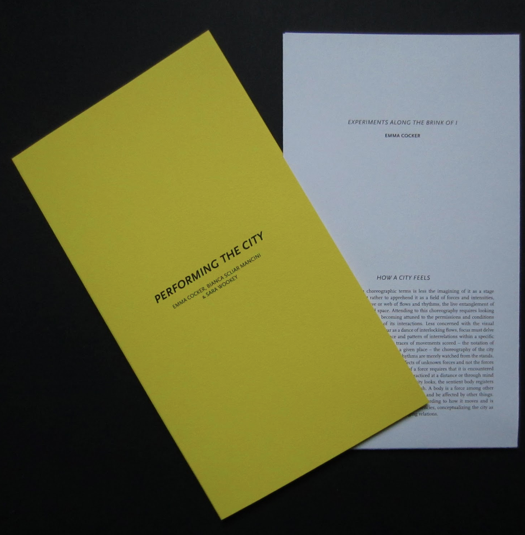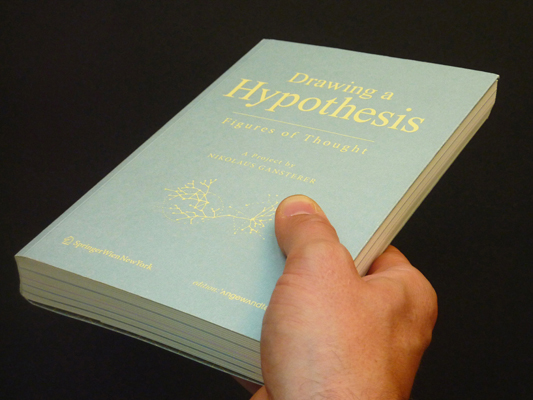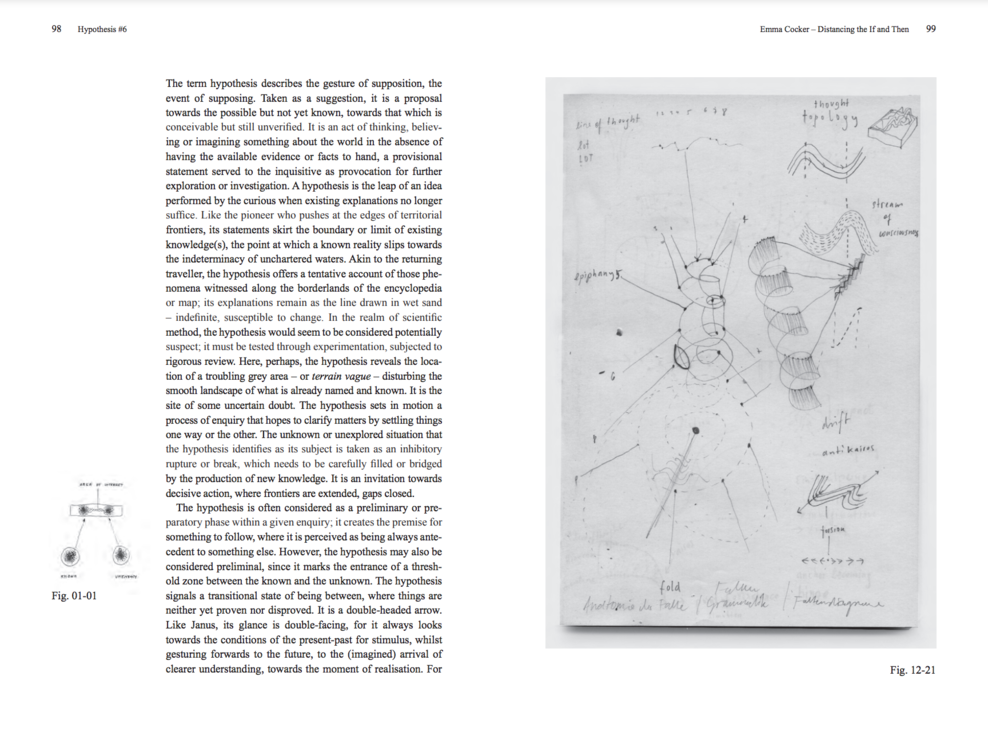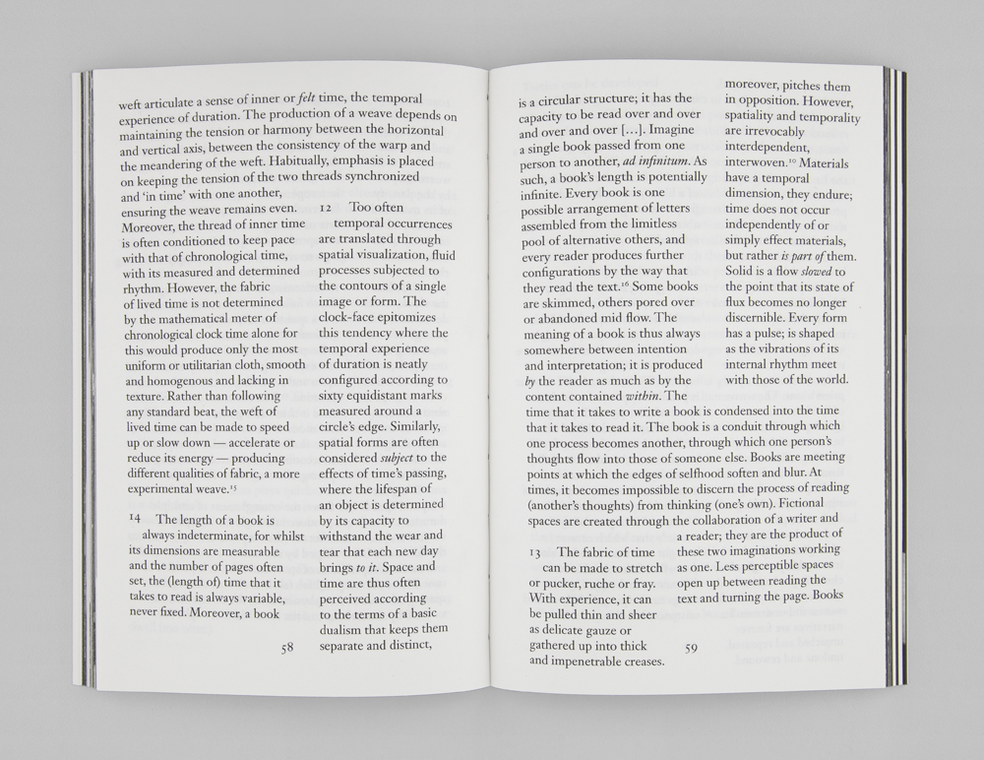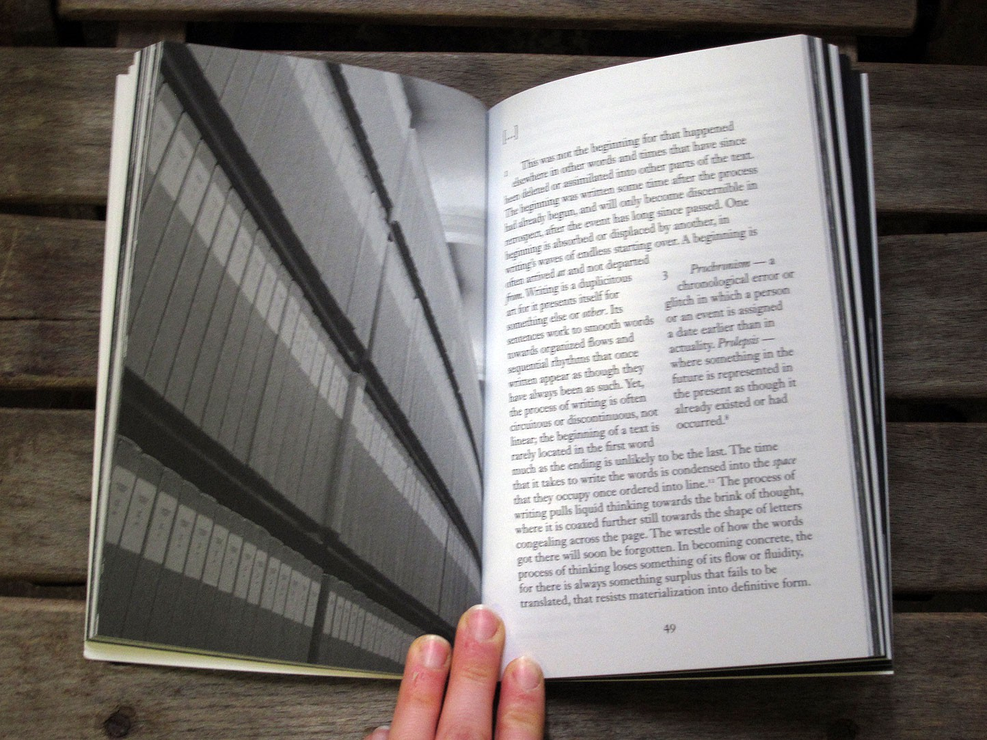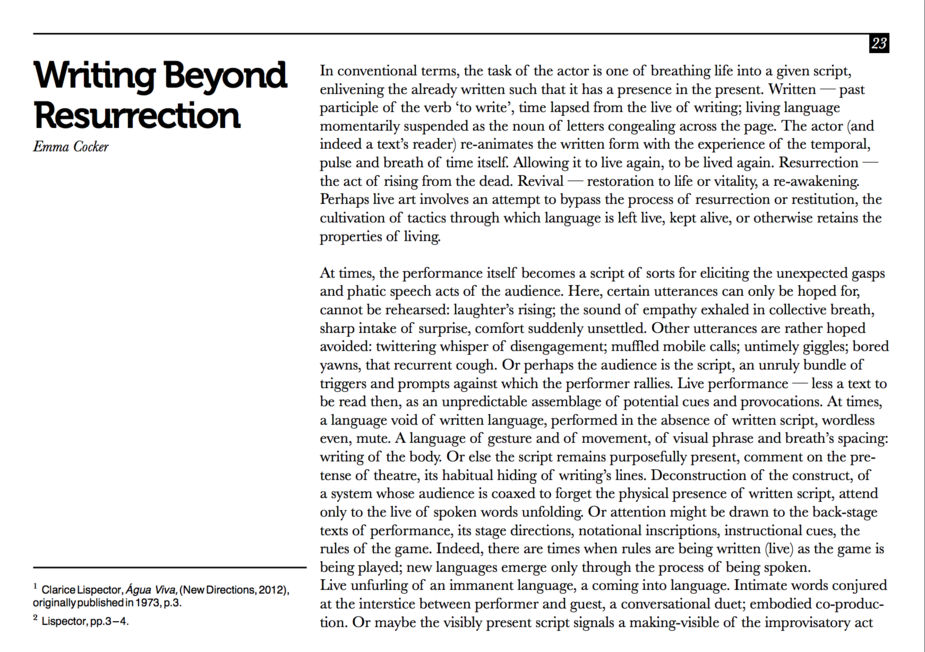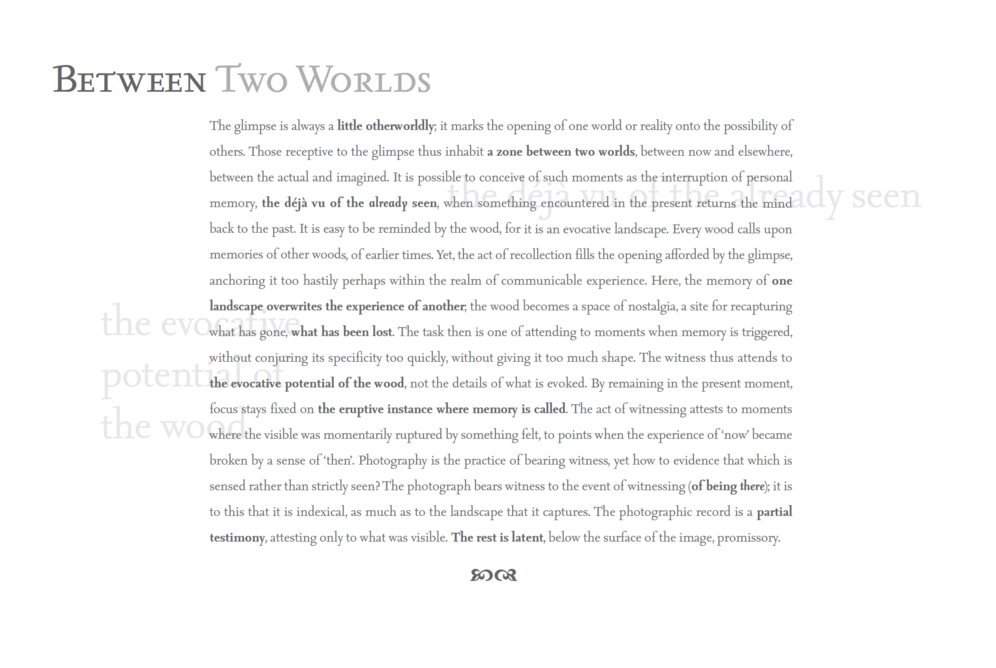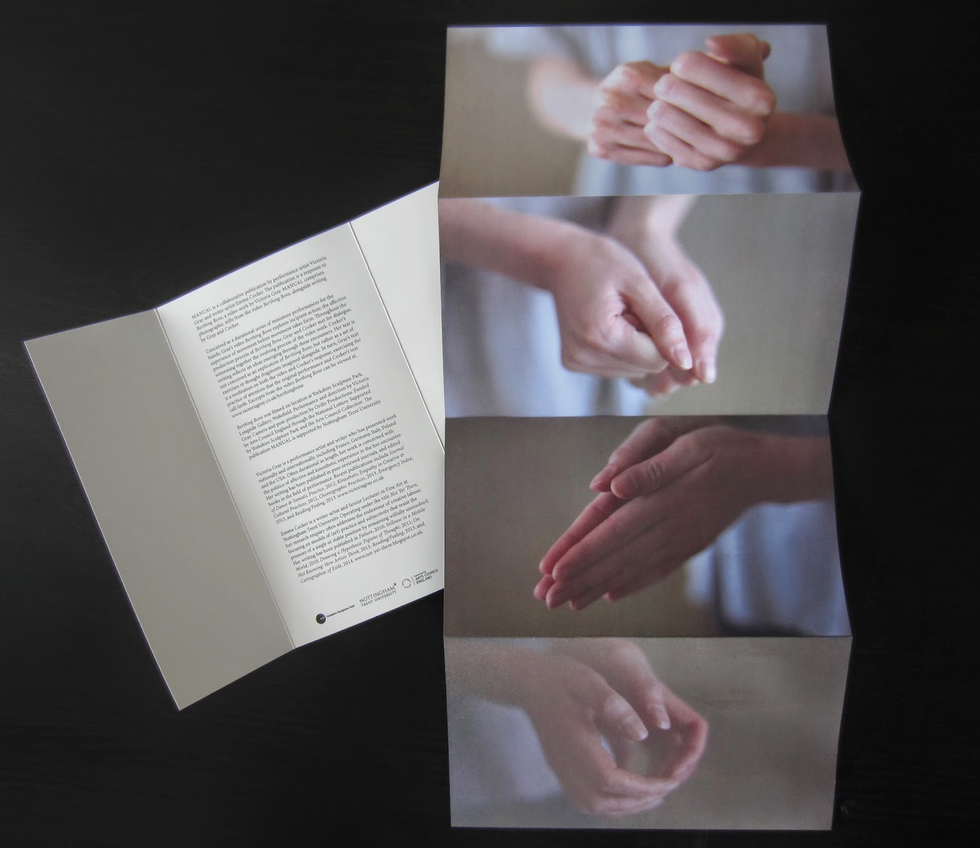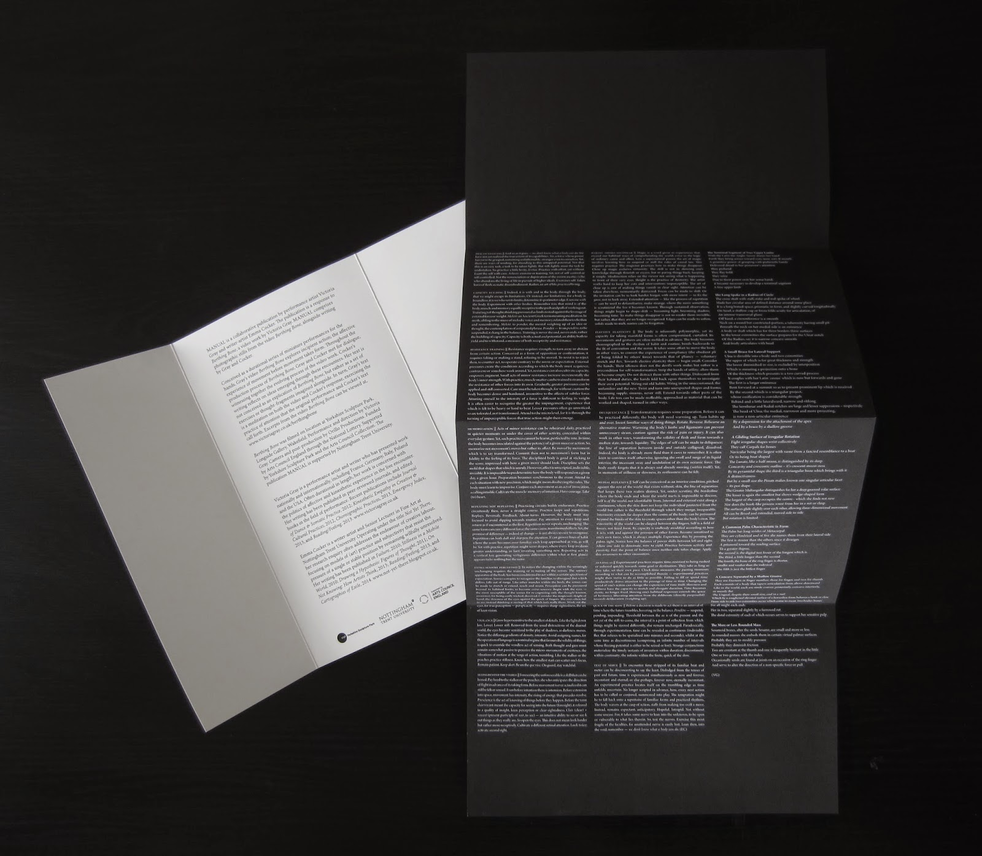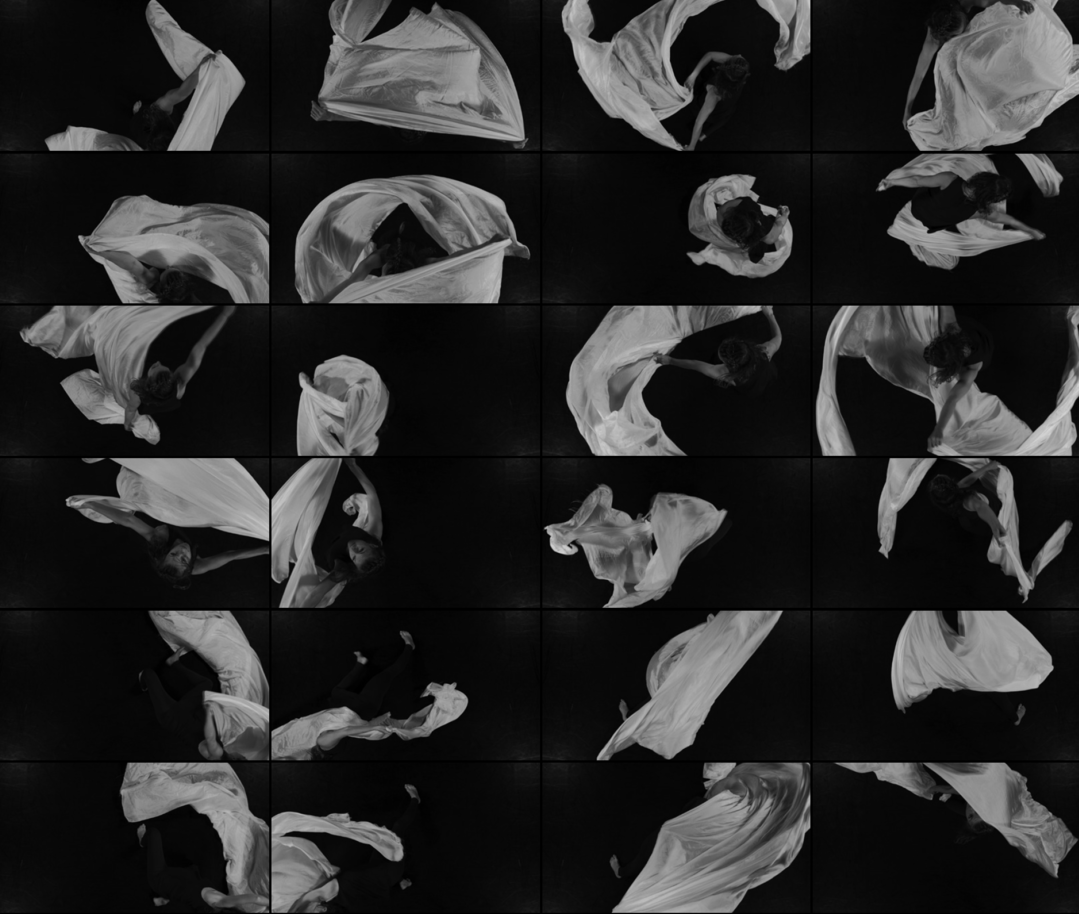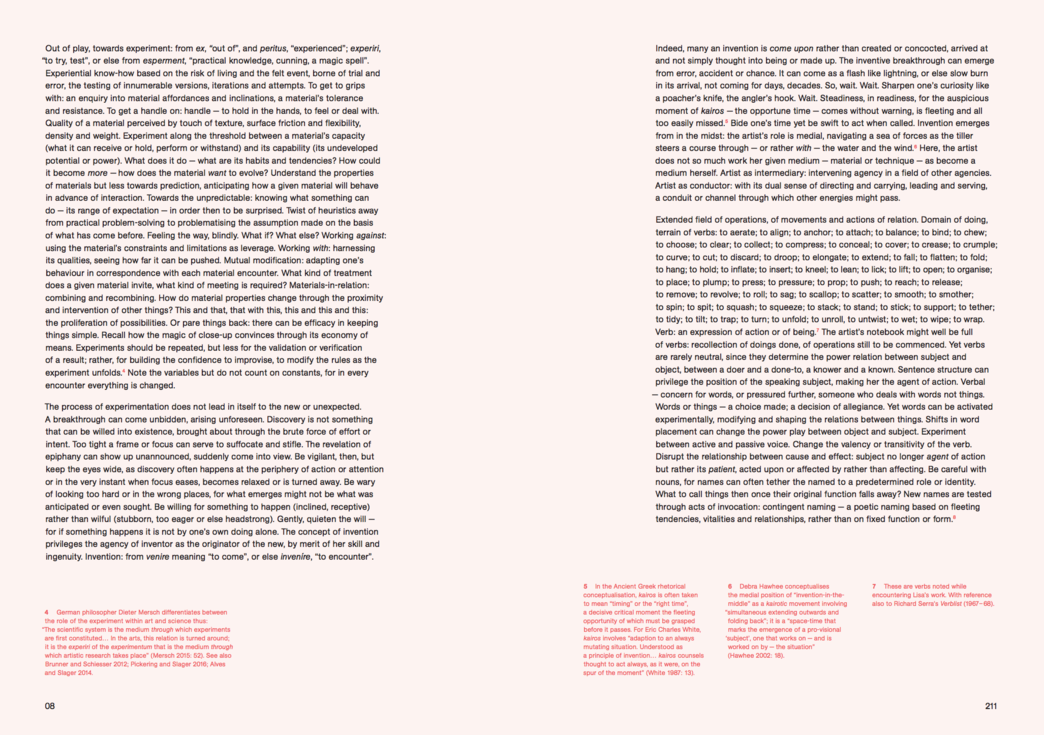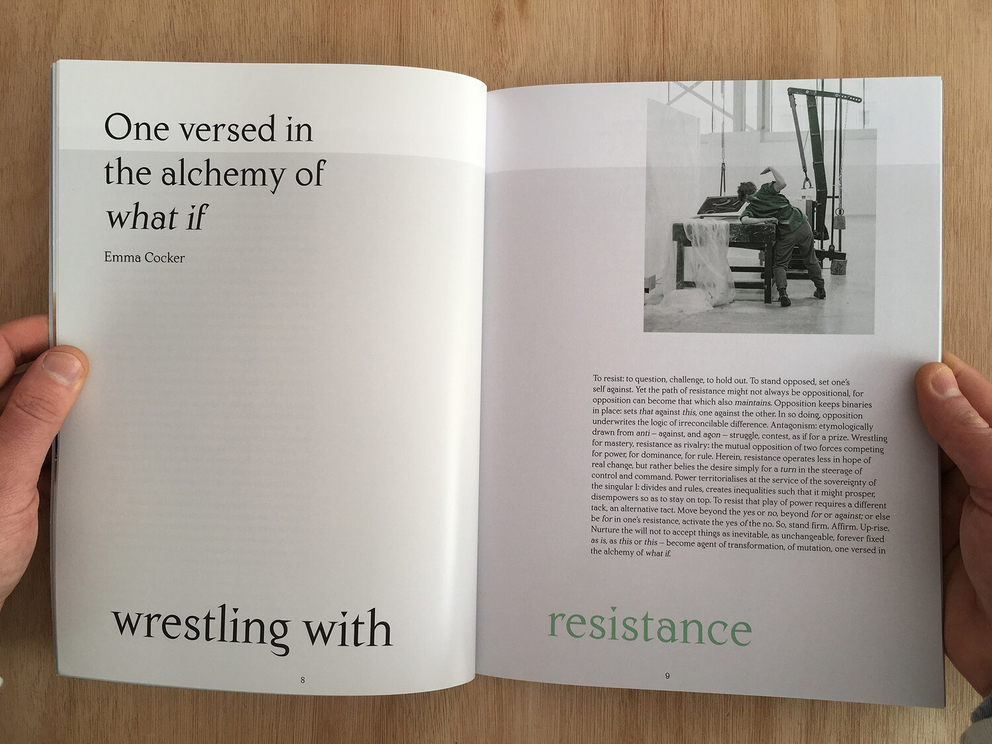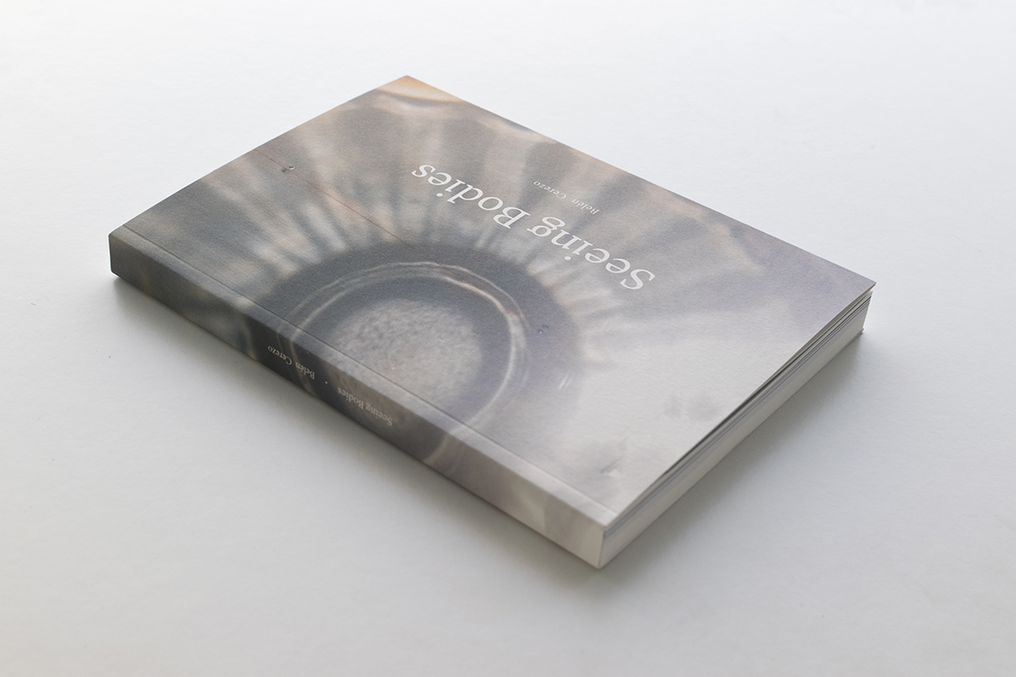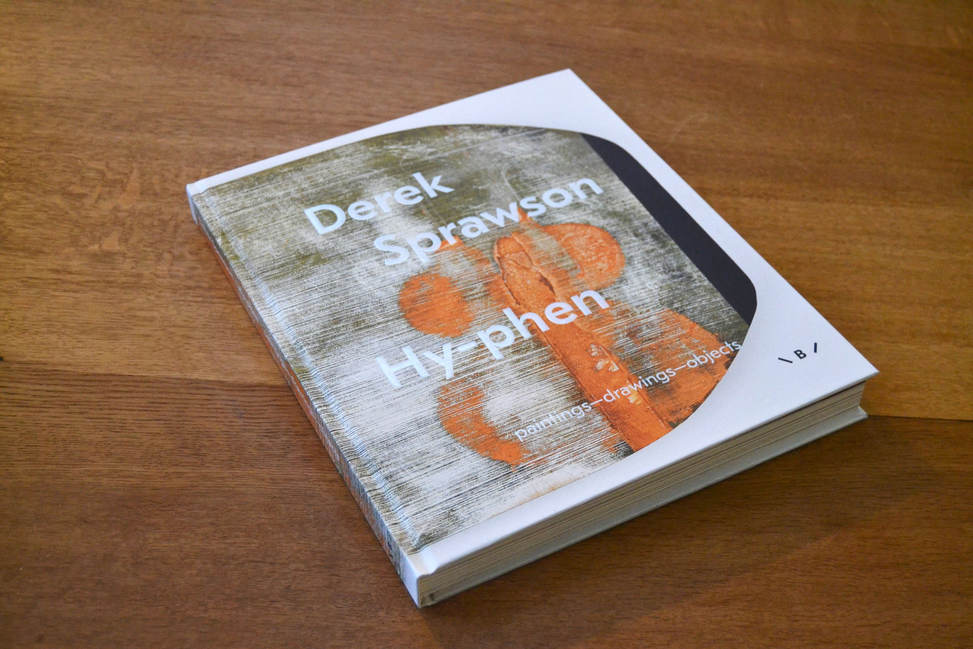For over a decade I have been developing a practice called ‘contiguous writing’, an exploratory creative-critical prose form that seeks to touch upon rather than being explicitly about. Writing from the position of inter- (both with and within). Writing with and against the resistance of the situation, of the page, of the body, writing dialogically with others. I ask: How might I write with, from within or through practice; indeed, how can writing be conceived as an aesthetic research practice?
Touch knows through contact made; its mode of knowing is not that of objective distance but of a subjective relation felt. Proximity. Intimacy. Contiguity. Adjacency. Touch knows from nearness, from being alongside, not by overlooking, not from above. To touch is to be touched — categories of subject and object are rendered unstable, unable to be clearly ascertained. Yet, touch extends beyond the cutaneous, beyond the felt frictions of surfaces and skin. For whilst the skin’s membrane can serve to separate self from world, a deeper touch invites their re-connection, through one’s willingness to be touched by, for being affected, for being moved.
Summer of Dissent (The Yes of the No)
Glimpsed, Only in a Certain Light
The Work of the Work, and When the Work Works
One versed in the alchemy of what if
Touched by a Lighter Sensitivity
Like the Lichen, As the Hyphen
Beginning with a meditation on the affirmative potential of no alongside the dissident capacity of yes-saying as a species of refusal, The Yes of the No advocates different models of daily practice through which to perform everyday life — the as is — in the subjunctive key of what if or even what might be. Existing in the space between imaginative proposition and a call to action, The Yes of the No is an assemblage of provocations, proposals and potential ways of operating — ranging from navigating the city and inhabiting the margins to errant acts of reading; from preparing for the unexpected to learning how to ‘not know’, from minor acts of singular sedition to collective expressions of an insurgent ‘we’.
The Yes of the No is the first collection by writer-artist Emma Cocker, which draws together selected fragments of writing produced in dialogue with, parallel to and as art practice (from between 2007–2016). Cocker’s writing often focuses on models of (art) practice and subjectivity that resist or refuse the pressure of a single, stable position by remaining wilfully unresolved. The Yes of the No takes the form of single-page prose paragraphs, which might be read in sequence or approached in the singular. Each page-paragraph is conceived as implicitly connected to others, yet with an identity (and name) of its own.
Between 2007 - 2010, I worked in collaboration with Open City on a number of research projects, resulting in the production of a serialized creative prose text that unfolded over a number of postcards and which were distributed in the public realm as provocations for thought and action. Between this period, Open City was an interdisciplinary project involving artists Andrew Brown and Katie Doubleday, working in collaboration with other artists and writers including myself. It took the form of an exploration-led project that attempts to draw attention to how behaviour in the public realm is organized and controlled – and to what effect – whilst simultaneously exploring how such ‘rules’ – even habits – might be negotiated differently through performance-based interventions.
Open City’s projects often involve inviting, instructing or working with different individuals to create participatory performances in the public realm, discrete art works that put into question or destabilize habitual patterns and conventions of public behaviour. In 2007, I was invited by Open City to produce a piece of writing in response to their work for a series of publicly distributed postcards, and have since worked more collaboratively with the project on a phase of research investigating how the different temporalities within the public realm might be harnessed or activated creatively; how movement and mobility affect the way in which place and locality are encountered or understood.
LINK TO OPEN CITY PAMPHLET
LINK TO TEXTWORK
The Yes of the No was written adjacent to The Summer of Dissent, Bristol, 2009. The Summer of Dissent was a season of covert actions and overt operations curated by Karen Di Franco and Sophie Mellor in collaboration with the artist-led space, Plan 9, in Bristol in 2009. The Summer of Dissent brought together a range of practitioners seeking to dismantle and reassemble cultural norms through collective action and singular acts of sedition. The programme invited participants to reflect on concerns around physical and psychological survival and to question current geo-political structure. 'The Yes of the No' is a result of the my interaction as writer-in-residence with the programme. The text provides a framework and overview of the themes, concerns and issues raised by the Summer of Dissent and its participants. See here for further details. The title of this text was also adopted for my solo collection of writing, The Yes of the No.
Extract
[...] Rather than taking up a specific cause against something else, dissent has the capacity to be constitutive (causal in and of itself), a critical and creative practice undertaken towards the production of new or unexpected ways of being in the world. Here, a shift occurs from being mobilised by external forces towards self-mobilisation, towards causing oneself to act. Dissent is a form of protestation against normative or hegemonic ideologies (whatever they might be), the desire to break or escape from the pernicious stranglehold of conformity and expectation. It is the rejection of prescribed and accepted cartographies of subjectivity in favour of a perpetual — daily and life-long — quest for new modes of creative inhabitation not yet fully mapped out or declared known. Dissension necessarily involves some degree of contrariness, founded as it is on the principle of not concurring or agreeing with the authority of dominant modes of naming and knowing. It makes no sense then to try to make sense of a practice hell bent on thwarting the logic of consensus. It would be at odds with the idea of dissent itself to pin down individual moments of rebellion or sedition within a broader genealogy (political, theoretical or otherwise). Dissent resists such familiar strategies of organisation and classification, for it perceives in them a nascent orthodoxy. Looking for other ways to inhabit the system — without being captured or constrained by it — requires that a given language or set of rules are no longer used to hold things in place, but rather become worked until malleable, bent back or folded to reveal other possibilities therein.
[...] Readiness is the state of being at the cusp of action, mind and body poised, awaiting signal. To be prepared is to anticipate the unforeseen future. Unknown situations, however, demand a speculative approach for you can never be wholly sure what to expect, what skills will be required. Yet, certain practices can be rehearsed daily: using your eyes; creating secret signs; receptiveness; reading maps; judging heights and distances; simple doctoring; stalking; learning to hide; plant identification; differentiating provisions from poisons; imagination; free speech; making fire; building bridges; early rising; whistling; wood whittling; weather wisdom, finding the North. Practice does not make perfect, rather a precarious capacity with no goal other than to be continually practised. Repetition of a singular action creates thinking space in which to contemplate strategy. Learning how to aim an arrow straight is to comprehend the vertiginous dynamic of a line of flight, to conceptualise an escape route. To prepare for the unexpected has a dual function: it is the gesture of getting oneself ready (for anything) but also of scarifying the ground, creating germinal conditions in which something unanticipated might arise. Emergency is both a state of crisis and the event of emergence, the brink of the new. Dissent desires to break with or defy expectation by willing into existence the unexpected, something unlike what has come before, the eruption of a form of thinking or being differently.
[...] The new or different is not something to anticipate passively like next season’s shoes. Better it be conjured from the conditions of the present, from what is already here and now. Surrendering to one’s circumstances does not mean to give in to the inevitable but rather to yield to the possibilities that each specific situation brings, learning to be resourceful with what is to hand. Reinvention is the practice of breaking down the familiar into a molten state in order to divert its flow, affecting a change in perception. New economies emerge based on alternative principles of asymmetrical exchange: theft and piracy, gift giving and donation, the art of losing one thing and finding something else. Lending should be treated with some caution however, for whilst it suggests generosity it often expects more back in return. To make do is not to manage with less nor hope for more, rather a call towards a life of creative action over dutiful consumption — an instruction to begin making and doing.
Performing the City (2012) is an artists’ bookwork that brings together material from Movement and the City, an ongoing research project-workshop led by Bianca Scliar Mancini and Sara Wookey, and Experiments Along the Brink of I, a prose response by myself [Emma Cocker] to witnessing and participating in Movement and the City workshops in Zagreg (2009) and Toronto (2010). Experiments Along the Brink of I is an example of ‘contiguous writing’ whose content evolved and emerged from a position of proximity, from being-with another’s practice, from working alongside and experiencing from within.
The first phase of ‘contiguous’ research took place within the frame of the fifteenth annual Performance Studies international conference in Zagreb, Croatia, June 24-28 2009. The theme of PSi # 15 was MISPERFORMANCE: Misfiring, Misfitting, Misreading. More information about the conference can be found at http://www.psi15.com/ In addition to presenting a paper as part of this conference, I participated in (UN)Folding Zagreb, a three-day collaborative workshop or ‘shift’ led by Sara Wookey, Bianca Scliar Mancini and Christopher Brunner.
Extract
GOOD COMPANY
A body’s capacity can be bolstered through association, its potential for action amplified through the company that it keeps. Its force or energy can fluctuate and waver, depending upon its surrounds. A body knows when it is in good company, for here it can be as much as it can be. There is some truth to the adage that strength can be found in number, yet there are times when three too soon becomes a crowd. Within the public realm, individuals are often grouped through necessity or habit as much as by desire or design. Waiting flesh gets pressed into ordered lines; unspeaking assemblages form in squares during the brief reprieve between morning and afternoon; tired limbs brush and crush during the rush hour, each body compressed to fit the cut of commodified time. Classificatory regimes usher individuals into preformed groupings all too easily; tick box scales package persons by age and place of origin, by sexual proclivity, colour of skin. Bodies are routinely assembled under the nomination of increasingly complex cultural codes, acronymic coordinates that fix and position an individual within the range of a predetermined grid. Community is the term often given to any loose association of bodies connected by location or geography or by some other common bond. Experiment with new ways of becoming collective, multiple. Refuse those orders that keep the body fixed and bounded, that force allegiance against the individual’s will. Gathered bodies might behave differently according to how they are named; possibilities of collective action can be augmented by a momentary change in the used noun. Practice with others the leaderless shimmer of a shoal of fish or flock of birds, a murmuration’s flight caught in the light of evening gloom, or the exaltation of larks ascending. Charm like finches –– wisp and drift and chatter. Avoid the unkindness of ravens, a lapwing’s deceit, the pitying of the turtledove.
FOLD/UNFOLD
Openness can signal towards a neutral state or a capacity for polyvalence. Electing towards an open state, the body becomes receptive to the force of other bodies, affected by its own volition rather than against its will. However, the open body is vulnerable to both threat and promise; it will need to cultivate resilience, develop its strength. Open the body gently then, with care. Limbs set in fixed ways will need time to relax, relax. Joints locked in rigid posture must be coaxed to flex. Flesh hung heavy might want persuading of its capacity for feeling, as much as for flight. As a solid entity the body is only too aware of its edges, its physical limitations, its distinctness from other things. Untrained the body is too conscious of its mass, its weight and density. It imagines itself as molded clay, flesh worn down at the hand of gravity and the pressing of time. To shift the body from thing to force requires a little alchemy. A body must be convinced of its power to shape-shift, its capacity for modifying its own condition, changing its very nature. Elemental transformation requires heat and energy; rising temperature might turn matter into its liquid state, cause liquid to become gaseous, air-born. Warm the body through folding and unfolding, through the rub and touch of skin on skin. Register points of tension and blockage as the body’s coils become untangled when extended to fullest reach. Let go of tightness of feeling; release the knotting of the hips, the clench of the jaw. Folding means to yield or surrender, it involves learning how to give. Yet this is not a passive act, for to fold the body back upon itself requires some agility, the same for the folding of thinking back onto thought. Breath makes the folding of self and the world palpable; the body holds something of the world’s air within its pleats, productive gaps can be nurtured in the creases between thoughts. Once folded, the body is rendered unfamiliar, incomprehensible. Consider a body morphed into unexpected contortions; not the involuntary torque and spasm of the hysteric body bucked against her will, but a body capable – like Houdini – of twisting itself (free) to avoid becoming trapped, immobilized.
LINK TO TEXT
Making Room for Manoeuvre was written contiguous to Urban Retreat. Urban Retreat (Close and Remote, 2010) was a series of artists commissions, activities and events reflecting on the use and value of urban/rural landscapes. It took Henry David Thoreau’s Walden as a starting point, using socialised seclusion and public interaction to investigate the local economic and ecological landscape of Barrow-in-Furness. Barrow’s unusual landscape charts its industry past and economic decline alongside its reclamation by both nature and current regeneration schemes. The commissioned artists examined the urban and rural spaces. Their aim, as artists have always done, was to record our enduring relationship with the land – which they did in a variety of ways with a range of materials themed around the urban and rural. Sophie Mellor spent a week as an urban wanderer relying on the kindness of strangers and the bounty of the land to house and feed her. Clothed in an especially designed survival jacket by Clare Thornton, she placed herself directly in Barrow’s marginalised landscapes, investing in its use and beauty through her interactions with people and place. Around this central, durational performance, there was a series of public events and activities. Lottie Child ran a Street Training session, investigating how to traverse both industrial and rural Barrow. Lottie has developed Street Training as a method to directly engage people with their surroundings through creative and playful behaviour combining parkour, movement, singing, conversation, games. Laura Oldfield Ford took participants on a drawing ‘drift’ (walk) around Barrow’s sites of regeneration, using drawing to reassess and document how industry, politics and economics have impacted the land and its use.
I attended many of these events, spending time in Barrow-in-Furness with Sophie Mellor during her urban wander, as well as exchanging postal correspondence with her. The resultant new writing formed the basis of the publication ‘Manual for Marginal Places’ published in Spring 2011. Manual for Marginal Places is a textbook for exploring the peripheral, acknowledging marginal acts as well as marginal places. There are no definitive ways of determining what is marginal. Marginal places come about through human agency, industrial decline or geographic remoteness. Marginal acts call for a type of tactical honesty – an acknowledgment of the median and an adroit détournement from the obvious and the everyday.
My text ‘Making Room for Manoeuvre; or, Ways of Operating along the Margins’ provides a lyrical discourse on modes and methodologies of sensing and encountering the marginal. These short pieces of writing, advocate a techné, or human skill, based on openness to the moment. Working from perceptions and experiences of the marginal, particularly in Barrow-in-Furness, she encourages the user to dispense with touristic convention and instead turn to brinkmanship. These texts are co-located alongside Sophie Mellor’s hand written correspondence from a week long experience of wandering the environs of Barrow-on-Furness. These notes detail her attempts to find food and shelter while relying on the kindness of strangers. Placed together within this manual they act as both suggestion and experience of self-reliance in a marginal place.
Extract
[...] KNOWLEDGE OF THE MARGINS
Do not turn to the encyclopedia, for its knowledge will not serve you well in this terrain. Its entries are redundant sooner than they are written. This landscape will have already changed. Taxonomies only extend the vocabulary for speaking a way through the marshland or mudflats or perilous scrubs. Shifting sands must be navigated with a certain lightness of foot; quickness of the land met with quickness of wit, sharpness of eye. These places will always fall between the gaps in language; leave you lost for words. Knowledge of the margins is not something that can be extracted and stored in dim-lit archives, but rather it is produced by them and then returned back. New ways of operating are required when habitual forms of knowledge no longer suffice. Build towards productive knowledge — the capacity to harness the indeterminate potential of a changing situation, the conditions of flux. Cultivate the power to not power over, attempt not to overpower but rather undertake, intervene. Make not take advantage, nurture the art of knowing how (and when) to work the situation well, of harnessing its chances. Recuperate lost and forgotten knowledge(s), those ways of doing things that have become mistrusted or marginalised as we have gradually turned away from knowing how. Practise the cunning of the poacher or the thief. Observe the laws of brinksmanship, of sailing close to the wind. Become a reader of auspicious signs and of the body’s unspoken language. Grow accustomed to the dark. Know how to disappear into the night and appear smaller than your size and that it gets colder just before the dawn breaks. Weave. Listen and observe. Lie in wait.
ON LEAVING THINGS OPEN
[...] To leave something open is to declare it unfinished or incomplete; a work in progress, still unresolved. Being open can signal towards a neutral state or the capacity for polyvalence, for manifold meaning. It is (a) not shut or closed; (b) having no protecting or concealing cover; (c) carried on in full view; (d) not closely defended by an opponent; (e) not sealed or tied; (f) having interspersed gaps, spaces, or intervals; (g) accessible; (h) free from limitations, boundaries or restrictions; (i) to speak freely and candidly; (j) to open (one’s) eyes, to become aware of the truth of a situation; (k) willing to consider or deal with something; (l) ready to transact business; (m) not yet decided, subject to further thought; (n) characterised by lack of pretense or reserve, frank; (o) free of prejudice, receptive to new ideas and understanding; (p) generous; (q) in operation, live; (r) to undo, to release from a closed or fastened position; (s) to remove obstructions from, clear; (t) to get (something) going, initiate; (u) to make or force an opening or gap in, to break the continuity of; (v) to make more responsive or understanding; (w) to reveal the secrets of, to bare; (x) to modify (one’s stance); (y) to accelerate; (z) susceptible, vulnerable. Open space is that which has yet to be territorialised, brought under private own. However, with openness comes vulnerability, for a space can soon become unruly in the absence of any rule. To leave something open thus carries an attendant risk, for it is an unprotected state whose facing edges remain exposed. An island is the land mass most marginal; its identity shaped by the exposure of its open shoreline and its perception of the risk therein. Danger might be averted by protecting the raw edge; treating it as an open wound or sore. However, the covered wound is often prone to fester; better then to trust it to the good of the air. Resistance is the tolerance garnered through an encounter with minor risk and danger; not the fear fostered in the attempt to maintain one’s distance, keep peril at bay. Openness thus cultivates resilience with receptivity. It is an operation of affirmation rather than of defense.
LINK TO TEXT
My text ‘Distancing the If and Then’ evolved through an intense process of exchange (a kind of ‘ping-pong’) with artist Nikolaus Gansterer as part of his publication Drawing a Hypothesis, where he would send me images and I would generate textual responses.
Drawing a Hypothesis is a reader on the ontology of forms of visualisation and on the development of the diagrammatic perspective and its use in contemporary art, science and theory. In an intense process of exchange with artists and scientists, Nikolaus Gansterer reveals drawing figures as a media of research which enables the emergence of new narratives and ideas by tracing the speculative potential of diagrams. Based on a discursive analysis of found figures with the artist’s own diagrammatic maps and models, the invited authors create unique correlations between thinking and drawing. Together, Gansterer and I, subsequently developed a performance lecture called Drawing on Drawing a Hypothesis. Using processes of cross-reading and live drawing, we dissected my publication Drawing a Hypothesis as a live event in the search for key words and phrases and evocative fragments in order to re-edit its content live.
Extract
Through the ritual of the experiment, the researcher practises the alchemical turning of the unknown into what can be known, the making consistent of what has hithertolacked form or definition. Yet, thresholds can be crossed in both directions, where what is known can as easily be transformed into what is no longer recognizable or certain. Here, another logic emerges wherein the hypothesis might perform differently, operating according to the terms of an alternative structure of experimentation and enquiry, less concerned with expanding the limits of what is known than with increasing the spaces of indeterminacy along its borders. This other logic is not a critique of the scientific method but neither is it the wholesale borrowing of its terms. Rather, it is the emergence of a concurrent way of knowing that reveals moments of porosity or elasticity within existing structures of knowledge, taking a certain pleasure in inhabiting these perceptual or cognitive gaps. Here, the hypothesis no longer identifies the presence of a temporary glitch in the fabric of knowledge such that it may be apprehended and its run stalled. Rather, it is the inquisitive finger that finds holes in anticipation of teasing them further open, for the pleasure of pulling at their loose threads.
Drawing’s hypothesis mobilizes the desire of the logical then, but thwarts its progress such that a conclusion never comes. It remains an incomplete or unresolved figure, promising the possibility of a revelatory moment whilst disabling the logic through which this might occur. Thought is brought to the quiveringbrink of realization, but its summation is indefinitely held back, unable to be reached. Predictions formed from an analysis of the drawing’s conjectural efforts are not those of rational reasoning but seem more akin to acts of divination or prophecy. Occult methods are borrowed as the means through which to conjure the drawing’s latent meaning, as familiar strategies of reading or interpretation fail to make sense of that which is abstract or obtuse. Conjecture is a form of perception led by intuition or insight, a portentous occupation. Indeed, conjecture has an archaic meaning, where it is defined as the interpretation of signs and omens – the quest, perhaps, for answers in the absence of other (arguably more rational) means. Drawing invites only the drawing of further hypotheses, made either by the artist as part of the line of enquiry or experimentation set in motion by the original conjecture, or else by the audience who are invited to form their own hypothesis in relation to the observable phenomenon witnessed at the site of the drawing itself. The drawn hypothesis is thus both a speculative act for making a statement about one set of observable phenomena, at the same time as presenting it as one which requires further analysis or explanation. The drawn hypothesis creates the first loop in a cognitive chain stitch of an interminable length and direction. This lasts as long as the thread of thinking remains dynamic and aleatory, where it is neither cut short nor reduced to snarled knots. Drawing works loopholes through which new thought may make its escape. Yet, opportunity (or kairós) is only so if taken.
The encounter with art provides the conditions – of potential indeterminacy – from which a hypothesis might be drawn, where the task becomes one of drawing the hypothesis in a way which remains faithful to the terms of the original stimulus (art). Significantly,the testing of the hypothesis must also be undertaken without simply reducing matters to the realm of the determinate, without simply making things at once stable. Drawing is the hypothetical figure deemed capable of describing the unfolding phenomenon encountered at the very site of drawing itself. In these terms, drawing is the kairotic event of creating an adequate epistemology simultaneous with the experience it attempts to describe, the restless instant where naming and the thing named attain co-existence (in time). It is the optimal means through which to communicate the nature of the observable – if somewhat intangible – phenomenon of drawing (and also perhaps of being) whilst demonstrating fidelity to its terms. Drawing is a form of hypothesis which attempts to account for its own coming into being, a reflexive practice performed asthe infinite loop of observing itself observing, ad infinitum. It is the hypothesis folded back to regard its own making; this being analogous to thinking about thinking – a Foucauldian inversion. Or rather it is that which is produced through the process of attending to and documenting the process of its own production.
LINK TO TEXT
My text entitled [...] was generated in and through the experience of encountering the work Inbindable Volume by Karin Kihlberg and Reuben Henry, and published in their artists' book Apeirophobia. Inbindable Volume is a three-channel video installation filmed in Birmingham Central Library (John Madin 1972). The library is the city’s most infamous example of Brutalist architecture, which was due for demolition at the time of filming. The rhythmic coordination of the three screens are driven by the voice of an omnipresent narrator who describes the lifespan of a building from conception to abandonment through a text which skips between past, present and future tense.
Extract
This was not the beginning for that happened elsewhere in other words and times that have since been deleted or assimilated into other parts of the text. The beginning was written some time after the process had already begun, and will have only become discernible in retrospect, after the event had long since passed. One beginning is absorbed or displaced by another, in writing’s waves of endless starting over. A beginning is often arrived at and not departed from. Writing is a duplicitous art for it presents itself for something else or other. Its sentences work to smooth words towards organized flows and sequential rhythms that once written appear as though they have always been as such. Yet, the process of writing is often circuitous or discontinuous, not linear; the beginning of a text is rarely located in the first word much as the ending is unlikely to be the last. The time that it takes to write the words is condensed into the space that they occupy once ordered into line. The process of writing pulls liquid thinking towards the brink of thought, where it is coaxed further still towards the shape of letters congealing across the page. The wrestle of how the words got there will soon be forgotten. In becoming concrete, the process of thinking loses something of its flow or fluidity, for there is always something surplus that fails to be translated, that resists materialization into definitive form […]
The length of a book is always indeterminate, for whilst its dimensions are measurable and the number of pages often set, the (length of) time that it takes to read is always variable, never fixed. Moreover, a book is a circular structure; it has the capacity to be read over and over and over and over […]. Imagine a single book passed from one person to another, ad infinitum. As such, a book’s length is potentially infinite. Every book is one possible arrangement of letters assembled from the limitless pool of alternative others, and every reader produces further configurations by the way that they read the text. Some books are skimmed, others pored over or abandoned mid flow. The meaning of a book is thus always somewhere between intention and interpretation; it is produced by the reader as much as by the content contained within. The time that it takes to write a book is condensed into the time that it takes to read it. The book is a conduit through which one process becomes another, through which one person’s thoughts flow into those of someone else. Books are meeting points at which the edges of selfhood soften and blur. At times, it becomes impossible to discern the process of reading (another’s thoughts) from thinking (one’s own). Fictional spaces are created through the collaboration of a writer and a reader; they are the product of these two imaginations working as one. Less perceptible spaces open up between reading the text and turning the page. Books unfold spaces non-reducible to their external dimensions; their interior space is never equivalent to the space that they occupy on a shelf. Thus, architectural models reveal little about the lived space of a library, since internal – fictive or imaginative – space is always immeasurable, boundless, inbindable.
LINK TO TEXT
Extract
Live language. Language gleaned from life. Cuts and extracts from the everyday, from conversations overheard or witnessed. Spoken testimony — an attesting to experience and to the experiential, to the live event of being-there. Live-ness of a voice still touched in the present by the recollection of an encounter now past, and the live-ness of an encounter with that voice, there in the dark. Fragility. Mortality. Humanity. Time passed and time still passing. Where is the present tense of language: in the act of speaking or of listening? Technology has enabled the possibility of a gap or lag in transmission between speech and its reception; the speaker and listener no longer must share space or time. There are certain events and speech acts that cross time zones or geographies, that somehow retain their presence, their urgency; their perpetual sense of now. Temporal loopholes. Words spoken back then, heard now. There, now here. Recorded voice can be felt in the present as though it were not of the past. Its significance can accrue over time, becoming more vivid, poignant, more vital and alive as the years pass by. Living is a condition open to change and growth, to evolving and adapting. An archival tendency often strives to stop this process still in its tracks, capture documents for posterity. So what constitutes a living archive? Performance/document. Live/dead. Binary definitions miss nuance. Technologies can display a live-ness of their own; live performance can sometimes lack pulse. Live might not always be lively; there is agency in action and inaction. Between one state and another, there is a range of possibility. A: zone of the neutral prefix, law of opposites paused. Atemporal — time suspended, freed from the limitations of chronological time. Alive: a suspended state of live-ness, neither wholly live nor lifeless. There are forms of practice that willfully inhabit these intervals and indeterminacies. Like writing?
Technology creates the conditions for new forms of live writing, the incessant babbling of real-time commentary, compression of the feedback loop such that reflection happens live to the event itself. Yet without sufficient gap or distance, reflection might lack depth, performed as the act of simply reflecting back, like a mirror, repeating, rather than reflecting on. Reflection (on) is an art of meditation, thought oscillating between the exterior realm of stimulus and the interior realm of response; hinge between self and world, past and present, known and not-yet-known. Reflection — from reflectere: to bend, to turn away. To reflect on live-ness is a troublesome pursuit, requiring one’s attention is kept on the present (now), whilst at the same time bent back, turned elsewhere. So, how to write of live-ness, of live art? How can the fixity of words on the page meet the experience of that which is endlessly disappearing as soon as it is coming into being? This is not just a question for live performance, for live art, but arguably also a writer’s preoccupation in and of itself. Here, a writing not wanting to be written (then resurrected by the reader), but rather striving to remain as writing.
LINK TO BOOKWORK
Extract
The art of seeing beyond what is visible is not performed through an increase in the pressure of observation, through closer scrutiny, more intensive inquisition. It is not a case of getting nearer to the wood, for this will only amplify its detail, bringing the visible closer into range. Different means of looking produce different registers of affect; it is a question of finding the right method. The scientific glance is perhaps too incisive. It strives to see beyond the visible by searching first beneath, anaesthetizing its subject before peeling back its layers. Nor will microscopic curiosity uncover the secrets of the wood’s interior. Its lens creates further opacity, rendering the visible only less familiar to the eye. The act of looking harder, more forcefully, causes the wood to retreat or withdraw, for it does not respond well to such advances. Patiently then, for the wood will not give itself up so easily, its trust must be gained. To see beyond what is habitually seen is not achieved by pushing the visible aside, for certain truths become too vulnerable if forcibly exposed. The visible is a veil whose logic is only ever lifted, briefly; momentarily let to slip or fall. Openings in the fabric of the visible are thus not so much produced then as encountered, fleetingly glimpsed. Here, the glimpse operates as an aperture in the real, a portal to other places and times, both future and past. The horizontal landscape of the wood’s present is ruptured by another frequency of experience, the vertical or vertiginous force of something felt or sensed. By catching both the wood and the witness off-guard, the glimpse is experienced as a poetic fall from or faltering within what is known or certain. It exists at the cusp of recognition, where the witness is left unable to fully find the words for communicating what they have seen.
The glimpse is always a little otherworldly, for it marks the opening of one world or reality onto the possibility of others. Those receptive to the glimpse thus inhabit a zone between two worlds, between now and elsewhere, between the actual and imagined. It is possible to conceive of such moments as the interruption of personal memory, the déjà vu of the already seen, when something encountered in the present returns the mind back to the past. It is easy to be reminded by the wood, for it is an evocative, even invocative, landscape. Every wood calls upon memories of other woods, of earlier times. Yet, the act of recollection fills the opening afforded by the glimpse, anchoring it too hastily perhaps within the subjective realm of communicable experience. Here, the memory of one landscape overwrites the experience of another; the wood becomes a space of nostalgia, a site for attempting to recapture what has gone, what has been lost. The task then is one of attending to those moments when memory is triggered, without conjuring its specificity too quickly, without giving it too much shape. The witness thus attends to the evocative potential of the wood, not the details of what is evoked. An attempt is made to remain in the present moment, where focus stays fixed on the eruptive instance where memory is called. The act of witnessing attests then to moments where the visible was momentarily ruptured by something felt, to points when the experience of ‘now’ became broken by a sense of ‘then’. Photography is the practice of bearing witness, yet how to evidence that which is felt or sensed rather than strictly seen? The photograph bears witness to the event of witnessing (of being there); it is to this that it is indexical, as much as to the landscape that it captures. The photographic record is a partial testimony however, attesting only to what was visible. The rest remains latent, below the surface of the image, promissory.
MANUAL is a collaborative publication by performance artist Victoria Gray and writer-artist Emma Cocker. The publication is a response to Berthing Bone, a video work by Victoria Gray. MANUAL comprises photographic stills from the video Berthing Bone, alongside writing by Gray and Cocker.
Conceived as a durational series of miniature performances for the hands, Gray’s video Berthing Bone explores incipient action; the affective experience of movement before movement takes form. Throughout the production process of Berthing Bone, Gray and Cocker met for dialogue, witnessing together the evolving process of the video work. Cocker’s writing reflects on ideas emerging through these encounters. Her text is not conceived as an explication of Berthing Bone, but rather as a set of exercises or thought-fragments imagined alongside. In turn, Gray’s text is a meditation on both the video and Cocker’s response, exercising the practice of attention that the original performance and Cocker’s text call forth. Excerpts from the video Berthing Bone can be viewed at, www.victoriagray.co.uk/berthingbone
Extract
PRACTICED LIVING || And so, as it goes — we don’t know what a body can do. We have not yet realized the true extent of its capabilities. We, a force whose power has yet to be grasped, remaining unfathomable, stranger even to ourselves. Yet, there are ways of tending, for attending to this untapped potential. Not that this is an easy task, a task to be taken lightly. But still, lightly must the task be undertaken. So, practice a little levity, levitas. Practice with effort, yet without. Exert the self with care. Askesis: exercise or training. Yet, not of self-control or self controlled. Not the renunciation or deprivation of the sworn ascetic; (s)he who abandons the living of life in pursuit of higher ideals. Exorcises self. Takes leave of flesh; ecstatic disembodiment. Rather, an art of life, practiced living.
CAPACITY BUILDING || Indeed, it is with and in the body, through the body, that we might escape its limitations. Or instead, our limitations, for a body is boundless, it is we who set its limits, determine its perimeter edge. Exercise with the body. Experiment with other bodies. Remember too, that mind is of the body, muscle and memory equally receptive to the push and pull of working out. Train(ing) of thought; thinking pressured as limbs tested against the leverage of external force or weight. Meletē: an Ancient Greek term meaning meditation. In myth, sibling to the muse of melodic voice and memory, related then to rhythm and remembering. Meletē: to ponder, the mental weighing up of an idea or thought, the contemplation of a repeated phrase. Ponder — from pendēre, to be suspended, to hang in the balance. Training is never the end, never ends, rather the building of capacity. Capacity is both actual and potential, an ability both to yield and to withstand, a measure of both receptivity and resistance.
RESISTANCE TRAINING || Resistance requires strength, to turn away or abstain from certain action. Conceived as a form of opposition or confrontation, it requires taking or making a stand, refusing to be moved. To resist is to reject then, to counter-act, to operate contrary to the norm or expectation. External pressures create the conditions according to which the body must acquiesce, contravene or somehow work around. Yet, resistance can also cultivate capacity, empower, augment. Small acts of minor resistance increase incrementally the body’s inner strength. With practice, muscle matter can be trained to transform the resistance of other forces into its own. Gradually, greater pressures can be applied and still converted. Care must be taken though, for without caution the body becomes dense and hardened, insensitive to the affects of subtler force. Attuning oneself to the intensity of a force is different to feeling its weight. It is often easier to recognize the greater the impingement, experience that which is felt to be heavy or hard to bear. Lesser pressures often go unnoticed, so are tolerated, not transformed. Attend to the micro level, for it is through the turning of imperceptible forces that true action might then emerge.
MEMORIZATION || Acts of minor resistance can be rehearsed daily, practiced in quieter moments or under the cover of other activity, concealed within everyday gesture. Yet, such practices cannot be learnt, perfected by rote. In time, the body becomes inoculated against the potency of a given move or action. So, memorize not movement’s moves but rather its affect. Be moved by movement, which is to say transformed. Commit then not to movement’s form but in fidelity to the feeling of its force. The disciplined body is good at sticking to the score, impressed with how a given move should look. Discipline sets the mold that shapes that which is unruly. However, affect is unscripted, indivisible, invisible. It is impossible to predetermine how the body will respond on a given day, a given hour. Preparation becomes synchronous to the event. Attend to each situation with new precision, which might mean disobeying the rules. The body must learn to improvise. Conjure each movement as an act of invocation, a calling into life. Cultivate the muscle-memory of intuition. Have courage. Take (to) heart.
VIGILANCE||Grow hypersensitive to the smallest of details. Take the light down low. Lower. Lower still. Removed from the usual distractions of the diurnal world, the eyes become sensitized to the play of shadows, as darkness moves. Notice the differing gradients of density, intensity. Avoid assigning names, for the operation of language is a nominal regime that favours the solidity of things; is quick to override the wordless act of sensing. Both thought and gaze must remain somewhat passive to perceive the micro-movements of existence, the vibrations of motion at the verge of action, trembling. Like the stalker or the poacher, practice stillness. Know how the smallest start can scatter one’s focus. Remain patient. Keep alert. Be on the que vive. On guard, stay watchful.
MEDIAL REFLEXIVE || Self can be conceived as an interior condition, pitched against the rest of the world that exists without; skin, the line of separation that keeps these two realms distinct. Yet, under scrutiny, the borderline where the body ends and where the world starts is impossible to discern. Self is of the world, not identifiable from. Internal and external exist along a continuum, where the skin does not keep the individual protected from the world but rather is the threshold through which they merge, inseparable. Interiority extends far deeper than the centre of the body; can be pressured beyond the limits of the skin to create spaces other than the body’s own. The exteriority of the world can be clasped between the fingers. Self is a field of forces, not fixed form. Its capacity is endlessly modified according to how it acts with and against the pressure of other forces. Become sensitized to one’s own force, which is always multiple. Experience this by pressing the palms tight. Notice how the balance of power shifts between left and right. Allow one side to dominate, now to yield. Practice between activity and passivity. Feel the point of balance once neither side takes charge. Apply this awareness to other encounters.
TEST OF NERVE || To encounter time stripped of its familiar beat and meter can be disconcerting to say the least. Dislodged from the tenses of past and future, time is experienced simultaneously as now and forever, inconstant and eternal; or else perhaps, forever now, eternally inconstant. An experimental practice locates itself on the trembling edge as time unfolds, uncertain. No longer scripted in advance, here, every next action has to be called or conjured, summoned into play. The temptation might be to fall back onto a repertoire of familiar forms and practiced rhythms. The body wavers at the cusp of action, stalls from making too swift a move. Instead, remains expectant, anticipatory. Hopeful. Intrepid. Not without some unease. For, it takes some nerve to lean into the unknown, to be open or vulnerable to what lies therein. So, test the nerves. Exercise this most fragile of the faculties, for unattended nerve is easily lost. Lean then, into the void; remember — we don’t know what a body can do. (EC)
LINK TO TEXT
Sampler of Samplers is an example of 'contiguous writing' developed through an encounter with the practice of artist Danica Maier. The text was published in Danica Maier, Grafting Propriety, (Black Dog Publishing)
Extract
The sampler: from exemplum. An example. In needlework, a test or task of sorts for demonstrating skill, variety of stitch practiced within a single frame. Over and over, again and again, stitch follows stitch yet each non-identical to the next in line. Incorporating a range of moves and methods — the sampler, site of both repetition and difference. Recognizable difference as running stitch folds over upon itself towards back, as chain stitch slips the lock of cross in unexpected loops and returns. Virtuous repetition of dutiful action momentarily breached by virtuoso twists and arabesques. Yet, even within the same species of stitch, variations in length and tension cannot wholly be erased. Even under pressure or duress the hand will not be made machine nor standard; embodied experience inescapably inflects every over and under of the thread. Every stitch records the lived instant of its own making, is woven through with the absent presence of she who was once there, now becoming dust. Sampler: from the French essamplaire — a model or role model, something to be copied through imitation. The sampler draws on an archive of existing patterns and templates, but invariably makes them her own. Act of copying a diagram or plan, yet rendering it physical, material. In the translation of the source book’s page, the deviation of the line from drawn to thread, from flat to three-dimensions. Inevitable interpretation. Deficits. Surpluses. Embellishment. Excess. In the copy, repetition and difference. Here then, the sampler — used to instill duty, obedience, even conformity in the young girl, might also provoke reflection on the possibilities for divergence from design, or else from expectation. Busying idle hands can lead the mind to errant wander as much as stay on track. The difference, as the devil, is in the detail. So, pay attention to variations in the thread, to the anomalies and glitches in routine process for herein might lie nascent subversion, subtlest of dissidence [...]
Whilst repetition can homogenize, flattening and eroding detail, repeated engagement with a given subject can also sharpen one’s focus or attention, nurturing a more nuanced gaze. For the practiced eye, the sighted flock challenges the finding of the right collective noun, discerning difference within what at first glance might seem indistinguishable. A flock. A fleet. A flight. Or a dissimulation — strange synonym it would seem for reflecting upon gathered birds on wing. Dissimulation — the act of feigning, of concealing one’s capacity or identity through disguise; omission of facts or detail to gain advantage. Like the predator pretending to be harmless, pretending to be prey. Playing passive. Playing dead. There are creatures that have learnt to mimic fauna, fallen leaf or inanimate rock. Camouflaged against their surrounds, they bide their time, until the time to bite. Others have evolved to imitate the seductive call of their own prey’s mate, luring them unbeknownst to risk or danger. So too might subversion be concealed within the meekest stitch, filigree patterns used to dazzle, obfuscate the content within. Drawing the viewer closer, a little closer, still closer … until. Yet, in nature, the imperative to imitate evolves from a will to survive as much as to aggress, guile practiced deftly in defense, in lieu of force. Wily is the insect that pretends to be the leaf so as not to be eaten by the bird. Or maybe it is compelled, some say, curiously drawn by the call of surrounding space; edge of self liquescent, figure becoming ground, form becoming void, void becoming form becoming stitch, stitch becoming line becoming language. Edges blur too in the swerve and shimmer of starlings caught in dusk’s ebbing light; singular speck of bird dissolved in wave of sheen and shadow, the collective murmuration irreducible to its individual parts. Or in the singular stitch surrendering itself to the service of pattern. Or the singular block of pattern repeated again and again, through duplication its original edges lost. Keen is the eye needed to spot the jog line, see each sole stitch, tell the insect from the leaf. Keener still the eye that can simultaneously discern both pattern and structure; stitch and image; mimic and the mimicked. Think of the illusion, how rare the seeing simultaneously of both the rabbit and the duck.
We are told that there is no outside, that to make one’s resistance visible exposes it to control. Still, ways to resist must persist, for the imagining of a future otherwise. Pro-test then — test the system to its limits through the advance of experimental means; cultivate one’s disobedience as an aesthetic practice. Towards a resistant poetics of reorientation — tilt of experience on its axis such that it can be thought anew; radical reorganisation of attention above and beyond the conditions of surveillance and subjugation.
Above and Beyond is a dialogue between artist Rose Butler and writer-artist Emma Cocker reflecting on the interplay between surveillance and resistance; how technologies and techniques of capture might be subverted, transformed into experimental tactics of protest and dissent. The publication was developed through a process of conversation between Butler and Cocker taking place over a number of years (2015—2018), a period marked by substantial political shifts and humanitarian crisis, an unprecedented increase in surveillance and security control.
This collaborative artists’ publication is conceived in response to Come and Go, a dual screen interactive artwork by Rose Butler that takes Edison’s early films of the Serpentine Dance as its reference with the dance phrases filmed from above.
Extract
Choreograph new forms of performativity in the gaps between the live and the mediated, in the seams between digital and analogue. Yet screen-based spectatorship can serve to sooth towards passivity, direct sensory experience somehow dimmed or distanced through the prism of the eye. Cultivate a deeper engagement beyond the regime of sight alone. Implicate the full senses of the self with others — become involved, entangled, intertwined. Necessitate the live encounter, an ethics activated in the relational proximity between the watcher and the watched. Affective attunement: empathetic play of affinity and synchronicity in relation to another’s moves. Respond to the call of others; give witness to the humanity of their plight. Towards an impersonal intimacy — experience of close connection that exceeds an individual’s bounds, anonymity as a precondition for human encounter beyond the labeling and limitations of predetermined names. Experienced in motion, the body is felt as verb and less as noun. Body as a process unfinished, unfolding. Exercise a range of mind and muscle movements to prevent the self from stiffening into stable form. Identified, the body is all too easily fixed, immobilised within a nameable mould. Without flexibility, the body loses its resilience, becomes easy to break (down). The resistance of the body must not be too rigorous then, too rigid in its stance. Practise litheness, lightness of touch. Make nimble moves — be quick to grasp, swift to remain ungraspable. Proprioceptive heightening — increased capacity to grasp the position of one’s body in relation to itself, the strength of effort employed in the activation of one’s moves. The agile body conceals its effort well; movements initiated from places least expected. Attend to the affective micro-gestures of the dissident body, its insurgent energy events. Renew one’s confidence in what the body can store. Abandon hard drives, their data all too easily corruptible or lost. Embody one’s knowledge — the muscle memory recalled in action, a knowing known only in its practise.
Though the lived life is increasingly under watch, still there are flows and forces that exceed the governance of surveillance and containment. Some things the camera cannot see, the pixel never know. Beyond the rational grasp of language or logic of the law — the persistent poetics of a resistant pulse that cannot be translated into data, exchanged as information. Ecstatic resistance: excessing the sensible, irreducible to utility or assimilation. Ecstasy: from the Greek ekstasis: ek- (out), stasis — to stand still, to cause to stand. Out-stand: to stand outside (oneself), to be removed, gone elsewhere. To be outstanding then — not to achieve or excel, but rather to hold out against, endure. Beyond the play of power: towards the incomprehensible energies of the impotent or wild. Consider the libidinal contortions of the hysteric; or the medium’s delirium, her babble of unintelligible tongue. Yet not without violence has the ungovernable been tied down and tried, subjected to the force of discipline or limitation. So be subtle in one’s unruliness, discreet in one’s revolt. Practised in its subtler forms, the body can fold back upon itself, open up a universe within. Uprising of imagination’s surge — pure potentiality experienced prior to any actualisation into form. Subtle: from the Old French — sotil, soutil, subtil — meaning cunning or wise, difficult to perceive or understand, detect or analyse. Or else, sub — under, and tilis, tela — a web, a net. Slight, sleight: wily weaving of being and behaving below the entrapment of the web. Whilst the meshwork of control is all embracing, its net is full of unpredictable holes. Often imperceptible, these openings might just become discernible through the subtle shift in one’s perspective, periodic turning in the angle of one’s view. Affective transformation of perceptual awareness: radical reorganisation of attention beyond that of habit or convention. Reverse the relations of inside and outside, slowness and speed, vertical and horizontal, up and down. Towards a resistant poetics of reorientation, the tilt of experience on its axis such that it can be thought anew, above and beyond the conditions of constraint and subjugation.
LINK TO FULL TEXT
The Work of the Work and When the Work Works was developed through a series of close encounters with artist Lisa Watts’ work and her Studio Activity Sheets approach over a period of five years, including witnessing the project/exhibition Skittish (Lisa Watts and David Kefford) at Vane, Newcastle (31 October–14 December 2013) and Skittish (Lisa Watts and Samara Scott) at The Tetley, Leeds (21 March–4 May 2014), as well as iterations of Watts’ exhibition Not a Decorator… at Sheffield Institute of Arts, Sheffield (10 February–5 March 2017) and Castlefield Gallery, Manchester (21 September–4 November 2017), alongside Hairbrained, Studio Activity Sheets + 32 Significant Moments: An Artist’s Practice as Research, a practice-based contribution by Watts to Care + Attend, a symposium event curated by Emma Cocker and Joanne Lee, as part of Unconditional Love, the Society of Artistic Research Spring conference, Chelsea College of Arts/University of the Arts London (30 April–1 May 2015).
The Work of the Work and When the Work Works is published in Lisa Watts, Four Hundred and Twenty Nine Significant Moments, Documenting An Artist's Research and Processes.
Extract
Notice the different registers of working and of work; the not working that is rest and the not working that is play; the work that is playful, and the play that is work. Attend to the thresholds where one becomes the other, and to the intricate relations and dependencies between. The working of the work: that often hidden or private process of artistic labour and endeavour, which shapes and is absorbed by the work itself. To work: to prepare or perform, do or make, construct or produce, to strive after, to set in motion. To work: create — manipulation of physical substances into a new state or form. Work up: generate excitation, agitation of emotion, to arrive at something through preparation. Work against: attempt to subvert. Work into something: to become more deeply involved, over time. Work through: to progress through complexity. Working as a warming, a making malleable or pliable. Work it. Work on. Work in. Work out. Work of sustenance: a means of living and of livelihood, that which supports and nourishes from below. Sustain rather than endure — for whilst endurance holds out against external pressures and pains unyielding, sustenance involves reciprocity, the provision of resources for nurturing the necessary energies for life. Sustain: to bear or withstand, but with a duty also of care. Work of maintenance: the hard work of handwork or of handiwork, from the Latin manu tenere, to hold in the hand — or else, to practice habitually, persevere continually. Performed with the hands, a mode of labour based on dexterity and the tactility of touch, the haptic interaction of forces and vibrations, surfaces and skins. Against the efficiency of machinic labour, its economy of maximum productivity with minimum wasted effort or expense. Against utility, if this means acting according to a predetermined function or purpose, operating only in the proper way. Towards a non-utilitarian efficiency: efficiency as spontaneity, the play of least effort. Effortless action does not mean taking the easiest route (which is often based on old habits or untested conventions); rather, attunement to the different flows and forces at play, where action unfolds not through imposition of will but through a cooperate capacity for keeping things aleatory, alive.
The artist’s work paradoxically involves the discipline of play. For play is not activity undertaken lightly; it requires commitment, the capacity for sticking at something beyond all sense of purpose, utility or reason. Not-yet-performance: a process of performing, the preposition (per —) indicating through, a forward-through movement, forming and deforming. Doing and undoing. Turning things over. Over and over, yet not the Sisyphean labour of exhaustive repetition, relentless and unceasing. Meaningless work, yes: yet not absurd, not futile. Play exhausts things as a method for inviting in something new. Its emptying out of sense or meaning is hopeful, makes a clearing for the unexpected to arise. Making material acquaintance: a getting-to-know things so as to not-know, familiarity for rendering strange. Yet, play is inherently wasteful, its expenditure of effort and energy does not require anything back in return.
Play has intention without expectation or goal; it is autotelic — from autos, ‘self’ and telos, ‘goal’ — for it has no end or purpose other than itself. Play resists coercion, for its meaning is intrinsic to it — emerging through it — where worth or value is not determined by external measure. It is a risky business too, for play is always uncertain, never sure of how things will turn out; balanced precariously at the precipice between boredom and enchantment, the known and unknown. Indeed, beginning something without fully knowing what is being begun requires heightened concentration and conviction, for it can be tempting to (re)turn to the ease of familiarity or habit, else lose one’s way, fall prey to doubt. Actively do nothing before doing something, forestalling the passive paralysis of a doing nothing borne only of restless procrastination and distraction. Play provides a space of radical and restorative openness if it is allowed. Capture the workings of this stage with care and caution, for the act of notation or reflection risks pulling the player out of play, rupturing her field of absorption or immersion. Playing a field of possibilities not yet fully actualised, it is hard to know what to record when the focus of enquiry is not yet clear or named, when a direction has still to be defined.
On Versed in the Alchemy of What If is an example of 'contiguous writing' written in response to the work of Clare Thornton, and published as part of the artists' book Materials of Resistance, which accompanied Clare's solo show at Plymouth Arts Centre.
I collaborated with Clare on an enquiry entitled The Italic I from 2014 (until she passed away in 2019), so the text was written not only in response to the singular exhibition Materials of Resistance, but rather from the close experience of being-with and thinking-with Clare (in relation to both art and life) over a period of many years.
Extract
To resist: to question, challenge, to hold out. To stand opposed, set one’s self against. Yet the path of resistance might not always be oppositional, for opposition can become that which also maintains. Opposition keeps binaries in place: sets that against this, one against the other. In so doing, opposition underwrites the logic of irreconcilable difference. Antagonism: etymologically drawn from anti ‒ against, and agon ‒ struggle, contest, as if for a prize. Wrestling for mastery, resistance as rivalry: the mutual opposition of two forces competing for power, for dominance, for rule. Herein, resistance operates less in hope of real change, but rather belies the desire simply for a turn in the steerage of control and command. Power territorialises at the service of the sovereignty of the singular I: divides and rules, creates inequalities such that it might prosper, disempowers so as to stay on top. To resist that play of power requires a different tack, an alternative tact. Move beyond the yes or no, beyond for or against; or else be for in one’s resistance, activate the yes of the no. So, stand firm. Affirm. Up-rise. Nurture the will not to accept things as inevitable, as unchangeable, forever fixed as is, as this or this ‒ become agent of transformation, of mutation, one versed in the alchemy of what if […]
Material enquiry, thinking-through-doing ‒ experimental play of the polished with the porous, rough and smooth, hard with the soft, flesh and metal, weighty and light. Imagined binaries mark out the pitch within which to work. Attend to the intervals between ‒ as an active space, against the force of habit. Test unexpected ways for moving from one position to another. Cultivate a more nuanced tolerance: learn how much something can withstand, how far it can be pushed or pressured before it breaks. Quest for optimal tension: a stretched condition. Challenge things to their limits; yes, but know when to instill breaks and rests. With tenderness, tend to material tendencies; a material’s bent, its leaning or predisposition to act in certain ways. Find its habits; its wont and won’t. Tendere ‒ to stretch; extend. Working against impulse or inclination can open up new affordances; capacities are not fixed except through expectation. Parallel practice of tempering ‒ to modify or import the qualities of resilience and elasticity through heating and cooling, through the mix and mingling of materials, conducive. Add levity for aeration, to avoid becoming too dense. Temper ‒ to strengthen through experience, toughen; yet also to soften, to downplay, tone down. To restrain within due limits: restraint as liberation not as limitation ‒ limit as desirable leverage, the enabling conditions within which to work. Working with resistance: intuit when to yield, when to assert or interrupt.
Between spontaneity and receptivity, control and letting go, affecting and being affected. Between push / pull. Striking the right balances, alliances, reaching constructive compromises. Com-promise: the making of a mutual promise. Here, to compromise does not mean to back down, become resigned; rather, it is an act of shared commitment ‒ together, the taking of a common vow. Navigating difficulty: productive struggle of forces figuring something out, working it through. A pledge is made between maker and materials ‒ not to strive to master but to work with. Grappling: coming to terms with a material’s resistance ‒ objects can exert a will and direction of their own. The extant power of every object can be exercised or exorcised, let loose or left to languish. Con-jure: to swear together, recognise affiliation. Deepening solidarity with materials calls for the dampening of authorial will. Notice one’s force amongst other forces, the entanglement of one’s own bodily being-in-the-world. Edges becoming porous: folding of object/subject, self/other. No-thing in isolation: in the flux of things … artist as operative, carrier of flow. To work with is to be worked with: reciprocal modification. Mutual materialisation: production of the self as a material process; malleable, also capable of change. Care of the self: not in guarded self-preservation or protection, but through one’s willingness to be transformed. Let go the grip of I; soften the edges of self.
Touched by a Lighter Senstivity; or, On How Not to Break to Egg, draws on the experience of encountering A Pool of Light, an immersive residency-based installation by Belén Cerezo, at the Collection Museum, Lincoln, May 2019; engaging in conversation with Belén on the work as part of a public event, but also from a close knowledge of Belén’s wider practice developed over a period of years. The text was published in Seeing Bodies, an artists’ publication by Belén Cerezo (2020).
Extract
Improvisation strives to circumvent the habits of repertoire, avoiding the familiar paths of the past repeating. Activated in the present moment, to improvise is to work with what is immediately to hand. Yet, this practice cannot be forced, for it requires a certain letting go, the subtle play of tact. Bide one’s time, for tact is the act of knowing when to hold back. Attuned action — a light touch, sensitive intervention. Not the heavy hand of brute mastery or control, but softly, softly, feeling one’s way. Thinking-with the situation live in the now of its emergence: listening out for what needs to be done. Allied to the faculty of reason, the eyes often strive to see, to seek, to know. Yet, to think with the body is a sensorial event — intermingling of sensation and perception, feeling and desire. Towards thinking- or rather thoughtfulness-in-action, for beyond the cerebral introspection or ideation of thought, thoughtfulness involves a state of absorption coupled with the cultivation of care and attention for others and their needs. Thoughtfulness does not grasp or reach for knowledge as something to possess or own. Rather, it is a way of being in the world open to the transformative potential of being touched.
Palpar — a Spanish word meaning touching-feeling: to stroke gently or to caress, to appreciate or understand. Palpation — to examine by touch, feeling for tenderness with the fingers. Palpable — capable of being perceived, the intensity of an atmosphere or feeling when experienced as if tangible. Touch knows through contact made; its mode of knowing is not that of objective distance but of a subjective relation felt. Proximity. Intimacy. Contiguity. Adjacency. Touch knows from nearness, from being alongside, not by overlooking, not from above. To touch is to be touched — categories of subject and object are rendered unstable, unable to be clearly ascertained. Consider hand touching hand — feel the meeting of forefinger and thumb, or else two palms skin-to-skin pressing. Which is touching, which is touched? Yet, touch extends beyond the cutaneous, beyond the felt frictions of surfaces and skin. For whilst the skin’s membrane can serve to separate self from world, a deeper touch invites their re-connection, through one’s willingness to be touched by, for being affected, for being moved.
'Like the Lichen, As the Hyphen' is an essay that draws on my engagement with Derek Sprawson’s practice spanning over a decade, from encountering exhibited artwork to witnessing studio experiments in formation, alongside ongoing conversations around shared interests and ideas. The text is for a new publication on Derek's work, and in a sense, is conceived as a collaboration.
Extract
The artist might begin from where they left off — an existing work or experiment in progress — repeating and modifying a given action or approach until exhaustion. Here, exhaustive repetition is not for the betterment of technique or application, rather a way of tiring out the tried-and-tested such that something else might then emerge, some inconsistency, anomaly or mutation. A habit is fatigued so as to release its hold, weakened or disempowered through the gesture of doing and redoing. Such a practice requires patience, the forbearance to stick at something, see it through. The artist must remain vigilant, mindful not to let the habit reinstall, alert to the possibility of both the unpredicted and unpredictable. The artist cannot make this happen, the process cannot be forced. The quality of attention is of an unthinking thoughtfulness or of thoughtful unthinking — receptive awareness capable of recognising the unrecognisable, of witnessing the un-thought […]
Anticipating the unknown or unforeseen is not like waiting for the arrival of one’s muse nor for divine inspiration. Beyond what the artist knows emerges from within the event of making rather than external to it, immanent to the process rather than necessarily coming from without. The artist collaborates with the unfolding work, sometimes leading in the process, at other times willing to be led. Whilst truth to materials involves using a material appropriately, without hiding or concealing its nature, the artist’s fidelity to materials comes closer to communion, an experience of shared participation or coming together within and through practice. Edging beyond what one already knows can involve leaning back, letting go of forethought plan or aim. The artist must loosen or lessen their intention, so as to fully intend. Intend: from intendre, to give attention, pay heed or else to hear. The artist listens to the emerging work, tending to what it wants. Hold backs, becomes a little shy. Here, shy is not timid nor afraid, suspicious or distrustful. Shyness is felt as heightened sensitivity to the affective experience of a relational encounter, increased susceptibility to the potential for awkwardness or even perplexity therein. So often the reflex habit of shy is that of shrinking, withdrawal from interactions or situations likely to cause discomfort or unease. The blush of shyness blooms as a line is crossed, a norm transgressed, control lost, in a moment of not knowing. A radical shyness feels the hot rise of embarrassment or of being caught off-guard, then turns towards that experience rather than turning away. Shyness embraced creates the conditions of voluntary vulnerability — through shyness an expanded state of openness, neither withholding nor closed off. Alternatively, the artist’s shyness is bashful — holds back and eschews attention such that the work itself has space to breath and become. Abash: to be put into confusion by wonder, admiration or by fear; to perplex or embarrass; to open wide or gape. To diminish or lower oneself: lose one’s self-possession. The artist lowers or lets go the willed force of their own I, enabling the practice to become truly co-constitutive, a co-emergent process of becoming involving mutual transformation of both the material and the artist.
